






FACILITIES MANAGEMENT JOURNAL VOLUME 32 | 05 MAY 2024 FM SOFTWARE Building robust foundations INTERVIEW Matt Chapman, CEO at SBFM 42 36 WASTE MANAGEMENT Dealing with non-recyclable waste 28 FM Clinic: What are the main challenges for the FM sector in meeting ESG standards? SUGAR HIGH FM in manufacturing focus shows the crucial role played by EMCOR UK at Britain’s leading sugar producer












































































































































































































new supplier
of products
of brands,
available with next day delivery.
ONE product,
need it QUICK. , Distribution Box 4 Outlet Cable Flexi Meter Tail Kit READER DISCOUNT CODE: APPLY SCAN ME SCAN ME SCAN ME SCAN ME
Your
thousands
hundreds
all
Need that
and

kpm media Unit 1 Mill Place, Platt Business Estate, Maidstone Road, Sevenoaks, Kent TN15 8TB Tel: 01322 662289
Editor Sara Bean sara.bean@kpmmedia.co.uk
Assistant Editor & Social Media Development
Sarah O’Beirne sarah.obeirne@kpmmedia.co.uk Tel: 01322 476815
Director & Designer Warren Knight warren.knight@kpmmedia.co.uk Mob: 0780 1947757
Sales Director Danny Grange danny.grange@kpmmedia.co.uk Mob: 07867 418994
Business Administrator Maxine Howell maxine@kpmmedia.co.uk
Accounts Diane Jarvis accounts@kpmmedia.co.uk
Group CEO Nigel Copp nigel.copp@kpmgroup.co.uk
Editorial steering committee
Alan Hutchinson, Facilities Director, Howard Kennedy LLP
Charles Siddons, Head of Operations, NHS Property Services
Darren Miller, Group Head of Real Estate & Workplace, Experian
Ian Wade, Head of UK Estates, British Medical Association
Lucy Hind, Senior FM Lecturer, Leeds Beckett University
Marie Johnson, Head of Workplace & Wellbeing, Nominet
Paul Cannock, Head of the Estates and Facilities Management Department, European Space Agency
Russell Wood, Senior Facilities Manager at Travers Smith LLP
Russell Burnaby, Head of FM, Regeneration and Environment, Brent Council
Simon Francis, Director of Estates and Facilities, The Institute of Cancer Research
Simone Fenton-Jarvis, Group Director of Workplace Consultancy and Transformation, Vpod Solutions
Wayne Young, Facilities Manager at DB Cargo (UK)
Total Average Net Circulation
12,150 July 2022 to June 2023

kpm media adopts a sustainable policy of using paper from managed forests. Printed in the UK by The Gemini Print Group www.gemini-print.co.uk
Copyright 2024 kpm media
The publisher does not necessarily agree with the views and opinions expressed by contributors. No material may be reproduced in part or whole without written permission from the editor. Editorial contributions are accepted on an all-rights basis only. Letters to the editor may be published in their entirety or in edited form and remain the property of kpm media. While due care is taken to ensure the accuracy of information contained in this magazine, the publishers cannot be held responsible for any errors in editorial articles or advertisements. Subscriptions are available to non-qualifying and overseas readers at £120 p.a. (UK), £160 p.a. (EU countries) and £240 p.a. (overseas-other). ©

We learnt of a new acronym HIPPOs (Highest Paid People in the O ce) at the recent Workplace Trends Spring summit (page 10). According to a presentation on the Chameleon Workplace, while 70 per cent of top executives, HIPPOs, think the workplace has been designed with them in mind, only 21 per cent of junior sta feel the same way.
It is not representative of your organisation when only the most highly paid people have a say in the o ice environment. This appraisal is all the starker when you consider research from Gensler which showed that the workplace is one of the few opportunities for many of us to connect with people who don’t necessarily share the same beliefs systems.
The good news is that across generations and living conditions, employees want to come to work for the same reasons, to focus on work, socialise with colleagues and meet up with their teams. It’s up to workplace leaders to ensure the ‘destination o ice’, o ers all the right conditions for occupants no matter where they are in the hierarchy.
While creating an o ice that helps attract and retain talent is important, as we’ve been reporting in our case studies, the o ice is not the only place where FM makes a di erence. Following on from articles on FM in prisons, FM in residential lock-keeper cottages and FM in the Government Estates, this month we visited a manufacturing plant.
In what was a fascinating day out at the British Sugar plant in Norfolk we took a tour round the huge site where the FM team is embedded into the production processes to help ensure the sugar from sugar beet is ultimately turned into the crystal you’d put in your tea, along with a range of other products. Turn to page 24 for insights into FM at the sharp end.
As always, we’d welcome your feedback about any aspect of the magazine, together with your insight into what’s happening in the FM sector.
sara.bean@kpmmedia.co.uk
MAY 2024 3 FMJ.CO.UK comment this month... FACILITIES MANAGEMENT JOURNAL JOBS Find your next role with the FMJ Jobboard Visit jobs.fmj.co.uk for hundreds of roles in FM and associated industries jobs. fmj.co.uk
SUPPORTED BY
EDITORIAL COMMENT



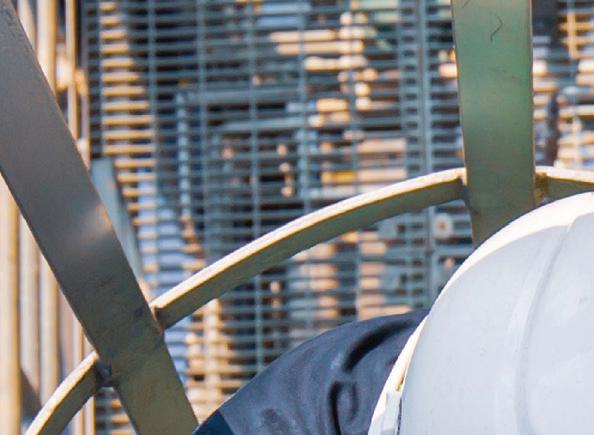













EXPERT FUEL SYSTEM INSPECTIONS
Protect your most important assets with an annual fuel system inspection (FSI) carried out by our expert engineers.
With a suite of 60 in-depth checks that cover all aspects of your fuel system, an FSI protects your business and local environment against leaks, spills and fuel contamination.
Get in touch today to find out more.
BENEFITS OF AN EXPERT FUEL SYSTEM INSPECTION







Includes a 60-point checklist Includes visual inspection, fuel testing & more End-to-end service UK-wide coverage for a range of sectors
Prevent problems before issues manifest
Find out more about our services here:



W: CROWNOILENVIRONMENTAL.CO.UK T: 0330 123 3399 E: SALES@CROWNOILENVIRONMENTAL.CO.UK






THIS MONTH...
This month’s summary of everything that has hit the headlines in the FM sector.
The latest news and views from membership organisations.
Sara Bean reports from the Workplace Trends Spring Summit 2024.





David Llewellyn of the Vending & Automated Retail Association (the AVA), discusses the rise in automated vending and how it supports the hybrid workplace.
14 Automated gates are legally defined as machines that require the appropriate safety protocol says Rob Williams of Gate Safe.
16 Headlines o en portray AI as a technology of tomorrow, but the truth is it is already revolutionising businesses and FM service providers today, says Regan Sparks from 14forty.
18 Karl Breeze, CEO at Matrix Booking advises FMs to make the most of data to build a sustainable workplace.
20 Research suggests that there are negative impacts of non-compliance on brand reputation. What are the main challenges for the FM sector in meeting ESG standards?




CASE STUDY
24

Account Director, Steve Thomson takes FMJ on a tour of the British Sugar plant in East Anglia to show how EMCOR UK is embedded into the production process.
WASTE MANAGEMENT
28 Small changes to waste disposal practices can help facilities managers hit ESG targets, says Helen Bentham of waste management company CSG.
30 Lee Knott, the Chief Executive of biotechnology business Advetec explains the benefits of turning non-recyclable waste into Solid Recovered Fuel (SRF).
HYGIENE
32
Sara Bean reports on the initiative between the British Institute of Cleaning Science (BICSc) and the Cleaning and Support Services Association (CSSA) in partnership with the University of Surrey, that explores innovation in the cleaning industry.
34
Dominic Folliss of Churchill on a science-led study that focuses on two key components of workplace hygiene.
INTERVIEW
36
Matt Chapman, CEO at SBFM explains why the so services supplier is keen to share its blueprint for better communications with front-line workers.
GROUNDS MAINTENANCE
40 As the UK experiences increased rainfall Karl Cundill of LitmusFM, looks at proactive maintenance plans that can be implemented to reduce the risk of grounds flooding.
SOFTWARE
42

















With an overwhelming choice of technology options now available, Esther Coleman, Product Manager at Idox, believes a CAFM system still provides the robust foundations required to manage facilities














































New product and service launches and company news from the FM industry.














51 Find out who’s moving where in the facilities management profession.
RECRUITMENT
52
Ilaria Cantelli, Education Manager at Uptree on the importance of improving social mobility through education and inclusive recruitment practices.
A new training programme helps prepare front-line personnel to manage conflict with simple strategies and universal guidance to manage interventions professionally and e ectively.
A brief roundup of the latest careers news in the facilities management sector.
Next Edition
British Land’s Broadgate FM team recently won the Facilities Management category at this year’s CIBSE Building Performance Awards and this case study outlines some of the carbon saving interventions that impressed the judges. In catering, FMJ talks to leading workplace foodservice suppliers about the variety of ways the contract catering sector is gearing up to tackle food waste and promote sustainability. In a focus on sustainable travel, we ask, how prepared are FMs to deliver EV infrastructure and how can you ensure your fleet rental arrangements are a greener option? In security; the tools within integrated security and surveillance solutions that can assist FMs in monitoring large-scale retail venues and how washrooms are getting smarter, greener, more hygienic and accessible.
MAY 2024 5 FMJ.CO.UK
PEOPLE
53
CAREERS NEWS 54
TRAINING
FEATURES 24 FM CAREERS 53 sara.bean@kpmmedia.co.uk
To register for your free copy of FMJ visit fmj.co.uk MIFM 44
COMMENT 12
COMPLIANCE
FAST FACTS
BLOG & SOCIAL MEDIA
FM CLINIC
ADVICE
OPINION NEWS & ANALYSIS 16 FMJ NEWS 06
ASSOCIATION NEWS 08
EVENT 10
CONTENTS Follow us on Facebook and Twitter @FMJtoday
AND
LEGAL VIEW


TAKE THE FEAR OUT OF FIRE DOOR COMPLIANCE LEGISLATION
Stuart Wilkinson, Head of Technical, RW Joinery
Fire doors are a legal requirement in all non-domestic properties, including commercial premises and public buildings, as well as blocks of flats and houses of multiple occupancy (HMOs). Used correctly, they stop fires from spreading through a building, giving people time to escape and the fire brigade time to attend and hopefully save the property.
Under the Fire Safety Act 2021 and Regulations 2022 – which were introduced to strengthen the Regulatory Reform (Fire Safety) Order 2005 following the Grenfell Tower Inquiry – building operators in England and Wales must appoint a ‘Responsible Person’ to manage all fire safety precautions, including fire doors.
This role often falls to facilities managers, who are legally bound to reduce the risk of fire spreading within the premises and do what is “reasonably practical” to ensure the safety of the people they are responsible for.
The definition of what is reasonably practical is open to interpretation, but in the event of a fire, FMs listed as the Responsible Person are required to prove they acted with due diligence. This highlights the importance of ensuring fire doors remain compliant. Failure to do so can lead to hefty fines and even prosecution.
The Fire Safety Order requires that fire safety facilities and equipment, including fire doors, are monitored under ongoing maintenance plans and kept in efficient working order. It also states that “competent persons” are appointed to support with risk assessments and preventative and protective measures. For someone to be considered competent, that person must be sufficiently trained, experienced, and knowledgeable to assist the Responsible Person properly.
FMs already have vast operational responsibilities, so it can feel overwhelming to know that something as onerous as fire safety is among them. However, accredited third-party experts can relieve the pressure and ensure premises remain safe and compliant, working with you to ensure fire doors meet the right standards and identifying where repairs or replacements are required.
When sourcing professional third-party fire door support, there are several key areas of expertise to look out for:
1. A one-stop shop: Choose a partner that can offer a full service, from design, manufacture and installation to ongoing inspection and maintenance, as this makes ongoing fire door compliance easier to achieve.
2. Industry standards: Ensure your fire door partner complies with industry standards and that their fire doors are certified and compliant with industry regulations. All fire door sets should be fully certified within the BM Trada Q Mark Fire Doorset Manufacturer’s Scheme.
3. Inspection: Routine inspections are necessary to identify wear and tear, damage, or signs of non-compliance. Ensure your fire door partner has the expertise to carry out inspections and provide reports and guidance on passive fire safety and how to maintain it. Inspectors must meet the standards of the accreditation body BM Trada.
4. Repairs and replacements: Timely repairs and replacements are essential to ensure there are no gaps in safety or compliance and that fire doors are there to protect in an emergency. Experts should also keep you informed of product innovations and any changes to regulatory standards.
5. Essential paperwork: You are legally required to keep comprehensive records of maintenance activities, including dates, actions taken, and certifications. A fire door partner will ensure all the right documentation is in place.
Remaining fire door compliant is not just the law—it’s also a matter of moral and ethical responsibility. By understanding regulations and employing the expertise of fire safety experts, FMs can arm themselves with the knowledge required to manage fire door compliance confidently.
NEW BESA SPECIFICATION WILL ‘REVOLUTIONISE’ BUILDING AIR QUALITY
A new specification for ventilation hygiene has been launched by the Building Engineering Services Association (BESA) as part of its ongoing e orts to minimise the risk posed by contaminated indoor air to human health and wellbeing.
BESA has also updated two of its air hygiene training courses to ensure delivery against the new specification and improve safety standards in buildings. The courses are designed so that contractors can advise their clients about ventilation cleanliness to help them meet health & safety obligations and comply with increasingly stringent legislation.



The Association said that TR19® Air ‘Specification for internal cleanliness and hygiene management of ventilation systems’ was designed to address an “urgent need for better cleaning and maintenance of ventilation ducting”. This has been highlighted by healthcare professionals as vital for reducing building occupants’ exposure to harmful airborne particulates and pollutants.
The COVID-19 pandemic also raised awareness of the role of e ective ventilation in reducing the spread of disease in indoor spaces and prompted a dramatic rise in the level of air quality monitoring.
BESA Technical Director, Graeme Fox said: “Employers and building managers have an obligation under health & safety legislation to ensure the indoor environment is safe and does not pose a risk to the health and wellbeing of workers and visitors. Cleaning ventilation ductwork has o en been considered one of those ‘out of sight out of mind’ tasks that can be postponed or avoided entirely to reduce cost, but the pandemic proved just how risky that strategy is. This new specification is a big step towards revolutionising air quality in buildings and it will help building owners and managers meet their obligations and remain compliant with legislation.”
IWFM PARTNERS WITH EQUANS TO EMPOWER WFM TO LEAD ON SUSTAINABILITY
The Institute of Workplace and Facilities Management (IWFM) has joined forces with Equans to help drive sustainability across organisations.
The workplace and facilities management (WFM) profession is uniquely placed to lead on sustainability, and net zero plans in particular, because it is the only function that brings together the needs of the landlord, the end-user, and the supply chain. Both the IWFM and Equans share a mission to change the perception of this lynchpin role in driving sustainability outcomes and impacts within organisations and across the built environment.
Through an initial two-year collaboration, IWFM will incorporate Equans’ expertise in thought leadership, insights and guidance to empower the profession in this mission. Together the partners will engage IWFM’s membership and broader audiences in the sustainability conversation and educate stakeholders on the purpose, actions, and potential of sustainability, challenging on the ‘what’, the ‘why’ and ways to do more and to do better.
Planned initiatives include:
• Sustainability Survey Reports 2024 and 2025
• Sustainability Guidance
• Hosting Educational Webinars and Awareness Campaigns
To accelerate the transition to a low carbon world and establish the profession and WFM organisations as a key di erentiator in achieving a sustainable world, the collaboration will see each organisation fully utilise their respective resources, such as the IWFM Special Interest Groups (SIGs) and engagement with external stakeholders, to positively act and measure, analyse and continuously improve sustainability outcomes over time.
MAY 2024 6
NEWS & ANALYSIS FMJ.CO.UK

WorldGBC calls on EU policymakers to prioritise sustainable built environment policies
A set of new sustainable building policy recommendations has been launched by the World Green Building Council (WorldGBC), in collaboration with 24 of its European Green Building Council members.
The ‘European Manifesto for a sustainable built environment’ has been designed for EU policymakers to implement more robust initiatives and incentives to secure sustainable buildings across the continent, the recommendations come on the back of mounting pressure from the building and construction sector to prioritise sustainable buildings policy ahead of June’s European Elections. WorldGBC says by prioritising sustainable built environment policies, several key issues across the EU could be resolved, including energy security.
The new set of recommendations call on EU politicians to commit to working together with the building sector on developing and implementing an EU policy framework that embraces the social, environmental, and economic benefits of sustainable buildings.
Spanning eight pillars, the recommendations comprise carbon, circular economy, health, water, finance, resilience, biodiversity and just transition.
To read the full European Manifesto for a sustainable built environment visit https://worldgbc.org/article/ ern-manifesto/
COMPLIANCE IS THE MOST SIGNIFICANT PROBLEM FOR MAJORITY OF BUILDING MAINTENANCE PROFESSIONALS


07-09 MAY 2024
UK




Seventy per cent of maintenance professionals state that staying compliant is the most significant problem in their business, according to a recent poll by SFG20.
Of those surveyed, just over half report that meeting safety standards is their biggest priority in 2024. However, all poll respondents (100 per cent of those surveyed) remain unsure about how prepared they are to comply with the Building Safety Act and the golden thread requirements for facility managers.
Consistently remaining compliant can o en be overlooked when maintenance budgets and strategies face rising costs of materials and labour. As the focus on compliance, highlighted in the Building Safety Act, grows, FMs are required to keep on top of their legal responsibilities whilst also pinpointing potential hazards, including electrical, structural, and fire safety, to prevent dangerous incidents and to protect people and valuable assets.
Paul Bullard, Product Director at SFG20, said: “Understanding your statutory responsibilities as a facility manager and the consequences of non-compliance is imperative. Not only does non-compliance increase the risk of legal consequences and sanctions, but it will likely lead to avoidable added costs, such as increased insurance premiums, and a damaged reputation.
“Building maintenance is no longer a backseat issue for organisations, but the cornerstone of health and safety, and e icient running costs. A ‘fix on fail’ approach might work for non-statutory maintenance, but the approach can mean statutory tasks are not completed, creating significant risk to both building owners and occupants.”
To watch the SFG20’s recent webinar ‘Building Maintenance Compliance: Do you understand your responsibility?’ visit https://bit.ly/44l3GSF
If you have any knowledge of FM news from across the world, please feel free to get in touch with our assistant editor Sarah O’Beirne email sarah.obeirne@kpmmedia.co.uk
08-09 MAY 2024 FOOTPRINT+ Old Billingsgate, London www.footprintplus.com
14-17 MAY 2024
Interclean Amsterdam RAI Amsterdam, The Netherlands www.intercleanshow.com/amsterdam
16-17 MAY 2024 Assist FM Conference Crowne Plaza, Glasgow www.assistfmconference.co.uk
21-23 MAY 2024
UKREiiF
12 JUNE 2024
Future of the Workplace conference Kings Place, King’s Cross, London https://bit.ly/43L4UGI
21 JUNE 2024 Property Connect Golf Day Tyrrells Wood, Leatherhead, Surrey https://bit.ly/4bzEZ7J 25-27 JUNE 2024
Construction Week London ExCeL London www.ukconstructionweek.com
Leeds City Centre – Royal Armouries www.ukreiif.com
InstallerSHOW NEC Birmingham www.installershow.com 01-02 JULY 2024
NEC
DATES FOR THE FM DIARY MAY 2024 7
Facilities Management Forum Hilton Deansgate, Manchester https://facilitiesmanagementforum.co.uk 11-12 SEPTEMBER 2024 Environmental Services & Solutions
Birmingham www.ess-expo.co.uk
FMJ.CO.UK NEWS & ANALYSIS
IGNITE YOUR CAREER – FM IS THE CAREER TO CHOOSE

Occasions


like this May’s World FM Day make clear how WFM’s purpose, functions and scope have made it the most exciting function of any organisation in the world today. Inspiring on sustainability, integrating smart tech, innovating the workplace experience. WFM (Workplace and Facilities Management) is a driver of change, enabling organisations to tackle challenges and opportunities and realise positive outcomes.
WFM’s wide range of career paths caters to a variety of interests and skills, a diversity which allows professionals to tailor their working lives to their specific strengths and aspirations. To that end, WFM can appeal to rich talent pools –think school leavers seeking an apprenticeship, graduates, the armed forces community, professionals returning to work a er a break
– in a way that other sectors may not. Indeed, professionals get the chance to positively a ect the lives of others through the creation and maintenance of healthy and productive workplaces.
In an era of swi technological change and hybrid work, where organisations want co-located and dispersed teams to do their best work equally, WFM is well-positioned to adapt to the evolving workplace landscape. A major benefit of a career in WFM is the ability to learn on the job while being able to upskill and reskill remotely, taking on training and qualifications that best suit the learner’s needs, circumstances and career goals. Modern buildings and services require specialised knowledge and expertise to operate and maintain, while today’s workplace is no longer just a physical space; it is a dynamic environment. With net zero and environmental action no longer niceties, organisations need to become more sustainable while hitting targets and
CIBSE LAUNCHES CHARTERED ORGANISATION PROGRAMME
ensuring value.
Companies are challenged with the skills gap, do they buy-in or do they build-up, whichever strategy companies adopt, an individual must take ownership to be their best version of themselves and to steer their way through a programme of development towards a meaningful impactful career, regardless of where they currently are in their career journey.
It is vital, if we are to build a better future, that professionals gain the knowledge, skills and behaviours that they will need to become more agile and adaptable. Whether you are new to the sector or an established practitioner, WFM and the world around it is evolving. By investing in learning, you and your organisation will be able to become a driver for change, benefiting people, planet and profit. Ignite your career in WFM and see what a di erence it can make to your life.


CIBSE recently hosted a highly successful launch event for its Chartered Organisation Programme, marking a significant milestone in the organisation’s commitment to promoting excellence in the building services engineering industry. The event, attended by industry leaders, professionals and stakeholders, received overwhelming support and enthusiasm.
During the event, CIBSE’s President, Adrian Catchpole, delivered a speech highlighting the importance of the Chartered Organisation Programme in showcasing competence and professionalism within organisations. He emphasised how the programme provides a robust framework for demonstrating competency, professionalism and adherence to the highest standards, enabling organisations to distinguish themselves as leaders in the industry.
This initiative underscores CIBSE’s commitment to advancing excellence in building services engineering and ensuring the highest standards across the industry.
RICS COMMERCIAL PROPERTY MONITOR REVEALS HIGH LEVELS OF OFFICE DOWNSIZING
Overhalf of the respondents to the Q1 2024 RICS UK Commercial Property Monitor results report an increase in the number of o ice tenants looking to downsize over the past year.
Although a net balance of +6 per cent of contributors saw an increase in occupier demand across the o ice sector

in Q1, on closer inspection, this rise was entirely driven by Central London, where the net balance moved from +3 per cent in Q4 to +40 per cent in Q1. Elsewhere, virtually all other parts of the UK exhibit either a flat or slightly negative trend in o ice tenant demand.
Drilling further into the sector, 52 per cent of contributors stated that they have witnessed an increase in the volume of o ice tenants looking
to downsize over the past 12 months. Alongside this, close to 90 per cent report seeing either significant or modest levels of o ice repurposing to other uses of late (up slightly from 86 per cent when this question was last included in 2021).
For the retail sector, occupier demand remains largely subdued, as respondents continue to cite a rise in vacant space across both the retail and o ice sectors at national level over the quarter.
While respondents are anticipating an upli in rents, these are predicted to fall across secondary o ices over the year ahead (net balance -36 per cent). These trends are broadly replicated across the regional data, with the only noteworthy distinction being that Central London prime o ice rental projections are firmer than the national average, at +54 per cent, representing the strongest outlook for CL prime o ice rents since Q1 2016.

MAY 2024 8 ASSOCIATION NEWS
NEWS & ANALYSIS FMJ.CO.UK
IWFM CEO, Linda Hausmanis

You may already have your smoke control system maintained by Colt. And other dampers serviced elsewhere.
Colt can save you money and time.
Streamline your smoke control and damper maintenance management, while eliminating the need for secondary contractors and call-out charges. Colt can take care of all your smoke control and damper servicing needs in one package.

Your legal obligation.
Fire and smoke dampers play a very important role in a building’s fire safety system and under the Regulatory Reform (Fire Safety) Order 2005, it is the legal duty of the ‘Responsible Person’ in your company to oversee their maintenance and testing. It is imperative that your dampers are maintained properly by a competent company.
Colt is just such a company.

The benefits of a service contract with Colt.
Colt is the UK’s leading and largest supplier of smoke control maintenance and as such, we have the largest team of engineers stationed up and down the country. Our team is dedicated to delivering quality service 365 days a year, 24 hours a day.
As well as getting you the UK’s most competent engineers, the Colt service contract comes with a whole host of other valuable benefits.
One call is all it takes to find out more. Call 02392 491735, visit coltinfo.co.uk/service-maintenance.html or email service@uk.coltgroup.com




Choose Colt
Service Expertise built on experience. Don’t pay twice for your dampers servicing. Call Colt once.
WORKPLACE TRENDS SPRING SUMMIT 2024
LEARNING OUR LESSONS
“We’re here to learn today” said Psychologist and Workplace Consultant Nigel Oseland in his introduction to the Workplace Trends Spring Summit 2024. A selection of data rich presentations ensured we did

Whatwe want out of our o ice is what unites us, was the message of Kerri Henderson and Naomi Sakamoto of Gensler. They posed the question ‘if the last three years has shown most o ice work can happen at home, what is its value?’ The answer is that the o ice remains one of the few places where people come together in social groups with people they didn’t choose, so rather than confining ourselves to communicating with people who agree with us, we’ve an opportunity to create more diverse and the research suggests, more productive groups.
Iain Shorthose and Steven O’Leary of Paragon Workplace Solutions shared their report, The Chameleon Workplace which asked, ‘have we still an opportunity to use the workplace as a competitive advantage as part of the employee value proposition?’ Worryingly their study revealed only 39 per cent of employees think the workplace was designed with them in mind, compared to 70 per cent of top executives who believe this. If we just design the workplace for the most senior people in the organisation they warned this results in a HIPPO (Highest
AI & VISUAL
The role of AI in the workplace was a big talking point of the day, and as O’Leary of Paragon pointed out, it is not something we need to survive but to help us to thrive. Paul Urmston, Area Workplace Manager at NatWest Group and Ian Ellison of Audieum, described how AI-powered workplace experience analytics has helped the banking group collate a mass of occupier feedback. As Ellison concluded, utilising an AI platform that processes multiple inputs can provide actionable insights that help improve the workplace environment.
Taking a visual approach to tech, Maria Tam, Spacial Psychologist at MAKE Architects presented research into how the positioning of video units a ect informal interactions between globally dispersed workers. Put another way, it assessed ways online communications can be designed to make us feel less awkward. "If this all seems too futuristic", said Tam, "consider the fact we are designing fitouts in buildings to last five, 10 or 50 years and with virtual communications
start to think about what that means for places where people live, play and work. The idea he said is to "provoke people to decide which scenarios they like and don’t like and help make the positive ones happen".
Hybrid ways of working are already impacting our cities, but the adoption of flexible working isn’t new, said Andy Lake, Author and Founder of Flexibility. co.uk and Smart Work Network who asked, ‘is it more of a case of old dog, new tricks?’ In a presentation touching on 30 years of studies into flexible working (including ‘teleworking’ from the 90s) he suggested "there is a following wind for the decentralisation of work and we have to embrace this, learning from what works well to innovate further".
INCLUSIVE DESIGN
tech being updated from one year to next – the spaces we design need to be adaptable now to meet our hybrid future."
In another visual take, Dr Harriet Shortt of the University of the West of England and Head of Visual Engagement, Bibo Studio presented research based on participant-led photography. This focused on sta within a large housing group who shared pictures that illustrate their everyday experiences of workspaces –both at home and in the o ice. Using these visual methods a orded some unique insights on workers’ personal journeys since home/o ice work patterns took hold. Two key takeaways were the importance of food and drink to connect us and how we need to o er o ice workers more opportunities to curate their space at work as well as at home.
FUTURE THINKING
Taking a broader perspective, Mark Catchlove presented findings from the Copenhagen Institute for Futures Studies and MillerKnoll on four possible future scenarios for urban living. His rationale was if we can understand the outside world of the cities, we then can
The conference was rounded o with two presentations on inclusive design. Matteo Zallio from the University of Cambridge revealed that design practitioners reported a lack of client awareness on the benefits of inclusive design, despite the research showing that for every £1 invested in this area, there was a return on investment of £100.
Empathy in design is talked about a lot said Kim Hutton, Ergonomist & Chartered Physiotherapist at Human Connections but how is it measured? By giving architects a set of tasks which they had to perform while wearing eye glasses and gloves that simulated loss of visual acuity and hand dexterity, the research revealed the barriers still faced by many people for whom inclusive design is supposed to help.
The main appeal of the Workplace Trends Spring summit is that most of the content is curated from recent applied research and data-driven case studies. This resulted in not only useful but actionable insights for workplace leaders operating in an uncertain world. https://workplacetrends.co/events/ workplace-trends-research-summit

NEWS & ANALYSIS FMJ.CO.UK MAY 2024 10
Paid People in the O ice) bias which could impact recruitment and retention.
insights, case studies & workshops to meet the challenges of today & tomorrow








Navigating excellence. Facilities & Estates Management Live October 2025 facilities-estates.co.uk Expert
RETAIL AUTOMATION AND THE NEW OFFICE

David Llewellyn, chief executive of the Vending & Automated Retail Association (the AVA), discusses the rise in automated vending across the workplace and how it supports the hybrid workplace

Withhybrid working now common practice within most businesses, facilities managers have been adapting how they run the o ice to suit the needs of occupants. This has included changing cleaning schedules and managing front of house shi s to match occupancy.
Another introduction is the use of automated vending and micro-markets. Across the UK, there is almost half a million vending machines and this figure continues to grow. Vending machines grant FMs greater flexibility and reduce catering costs while still providing fresh, high-quality food and beverage o erings.
HOW HAS THE VENDING MACHINE CHANGED?
The COVID-19 pandemic saw a rise in demand for on-the-go retail options that didn’t require human interaction. Since then, investment in automated and 24/7 retail has grown. In response, vending operators are constantly innovating and improving their o erings to meet the evolving demands of customers and businesses.
According to the most recent AVA Census, co eeto-go products rose by six per cent in 2022, with the anticipated 2023 census likely to show a greater rise in demand. Additionally, co ee-to-go revenue grew by 13 per cent compared to 2020. Today’s vending machines go far beyond the simple chocolate bar and packet of crisps. Technological advancements have introduced the capabilities for higher quality products to suit consumer needs. Many co ee-to-go machines now o er exclusively bean-to-cup co ee with fresh milk that can be hot cold, or steamed to the customers
preferences, with di erent payment options to be as accessible as possible to the customer. The AVA Census found that cashless payments are available at 65 per cent of vending and automated retail outlets, with 72 per cent of payments at these stations being cashless compared to 34 per cent in 2017.
For FMs with catering and refreshment services as part of their role, it is important to ensure that they are providing the right refreshments that people want. One way that many locations have been able to do this successfully is through the introduction of unattended retail facilities, including micromarkets. According to the AVA Census, there are now 480 micro-markets in the UK, with 70 more installed in 2022 and a growth trajectory of 17 per cent.
EMERGING TECHNOLOGY
The micro-market serves as a quick and straightforward system whereby customers can choose what product they want from the shelves and pay on exit at a cashless payment kiosk. Many businesses are looking to adopt micro-markets into the workplace to make the workplace a more attractive place to be, and to encourage the return to o ice-based working. Micro-markets allow this, enabling businesses to continue the flexibility that so many employees want, aiding employee retention, while reducing additional costs associated with a fully sta ed ‘traditional’ canteen. While conversation in the FM industry has
been heavily focused on artificial intelligence and machine learning, we can expect that micro-markets will utilise other emerging technologies. This will likely pave the way for further developments within micro-markets and vending, providing the ability to monitor consumer behaviour to inform stock or prices of certain products and curate the best stock program in alignment with occupancy data to ensure occupants always have access to products without loss of revenue or food waste.
AVA Census found that operators are now collecting customer choice data, with almost 75 per cent of machines being ‘connected’ using either telemetry or handheld devices, up from 45 per cent last year. This data collection, which can be shared with FMs, tells us what consumers are buying, at what time, day, and at what frequency. Having access to this information enables FMs to react quickly when something is low on stock and ensure favourites are always available.
The vending sector is futureproofing and prepared to meet changing consumer behaviour surrounding contactless payments. The adoption of cashless and operational management systems has increased significantly in recent years, partly due to the pandemic, and the continued commercial growth of the market. Implementing this successfully will help businesses to reduce overall costs, while ensuring their employees have refreshments on the go.
FLEXIBLE STOCKING
With flexible working comes flexible stocking, which creates an e icient and reliable system. Not only are consumers looking for higher-quality products, but there is also a rising demand for healthier food and drinks. Should FMs not cater towards the changing preferences of consumers, they risk alienating clientele, and occupants may be less likely to attend the o ice as a result.
FMs can utilise vending to respond to the changing needs of occupants, creating a competitive advantage that o ers more convenience than the high street. The use of automated retail and vending is bringing great benefits and o ers occupants a range of food and beverage options that reflect their preferences and dietary requirements. Making those needs accessible and easily managed through the use of automated vending and retail makes the lives of FMs easier and creates a harmonious partnership that can continually adapt in line with o ice occupancy.
MAY 2024 12
COMMENT
ADVICE & OPINION

A smoke control service contract with Kingspan Light + Air = Compliance made easy.
Regular servicing and maintenance of smoke ventilation systems is critical. Our dedicated team of engineers work with clients to regularly inspect and test smoke ventilation systems to ensure that they are working properly and are fully compliant with local regulations.
How can we help?
Kingspan Light + Air has been a trusted partner for thousands of commercial and industrial properties all over the world for over 30 years. From planned, preventative maintenance to rapid response repairs, we offer comprehensive service and maintenance packages for our smoke control and natural ventilation systems – giving you complete peace of mind that your systems will deliver the performance you need to keep your buildings operating at their best.
Tailored to your needs
We understand that each building is unique and that’s why we tailor our maintenance plans to meet your specifi c needs. We offer a range of packages, including both annual and multi visit annual contracts for smoke ventilation system maintenance.
Kingspan Light + Air
T: +44 (0) 29 2077 6160 E: KLAUKServices@kingspan.com www.kingspan.com/gb/en/business-groups/kingspan-light-air




Your legal responsibilities
Smoke ventilation systems play a very important role in a building’s fi re safety, which is why it is imperative that they are maintained properly by a competent company. This is a requirement of the Regulatory Reform (Fire Safety) Order 2005.
Talk to us about a service contract
Our experts are available nationwide 24/7, 365 days a year to respond to system failures and call out requests. They are also equipped to perform remedial works and preventative refurbishment to replace older or broken equipment as they carry a comprehensive stock of spare parts.
COMPLIANCE
AUTOMATED GATES ON SITE ARE THEY SAFE?

Automated gates are a regular feature on commercial properties. However, these gates are legally defined as machines, and as such, if the appropriate safety protocol is not adopted, they are capable of inflicting serious injury and ultimately can cause a fatality, warns Rob Williams, Technical and Training Manager, Gate Safe
Since the inception of Gate Safe in 2010, there have been positive developments in terms of an improved awareness of the required safety features for automated gates that should be present on any installation. But, there still remains a degree of ignorance in relation to the steps that need to be taken to create a gate that has been designed with safety as the primary consideration. The growing number of falling gates accidents is an indication of the dangers associated with a failure to apply a ‘safety by design’ approach – so avoiding the consequences of a single point failure. Court cases following fatalities caused by falling gates have resulted in fines as high as £500,000. Simply following the British Standards will not ensure a safe and compliant installation as stated by the HSE.
Facilities managers will be bound by a legal responsibility to check the ongoing safety of any automated gates or barriers on site – these gates must be safe to use and regularly maintained according to the Health and Safety at Work Act 1974 / Workplace (Health, Safety and Welfare) Regulations 1992 and as advised by the HSE.
GUIDANCE FOR FACILITIES MANAGERS
Any facilities manager who assumes responsibility for a site where automated gates or barriers are present who has yet to experience any kind of accident associated with these installations should not be complacent.
First ask the question, have these gates been regularly maintained? This is a legal requirement and you will be held accountable in the eyes of the HSE if an accident does occur that is linked to poor maintenance of the installation. Records should exist defining when the gates were last checked.
The next question should be, was the person who checked the gates suitably trained and competent? They should have undergone specialist training
to understand the dangers associated with these installations, and the steps that must be taken to mitigate any risks. A thorough risk assessment should have been conducted at each maintenance visit and there should be clear evidence of this.
Assessments should always be conducted with an open mind. While no-one is keen to admit that they’ve made a mistake it’s important to acknowledge that sometimes important risks are missed, especially if the person had not undergone adequate training. The focus should always be on accepting that mistakes can be made, but not to compromise on the safety of the installation going forward.
If there is a dispute between what the original installer is saying, and the subsequent maintenance provider in terms of any risks associated with the installation, always seek out an independent assessment of the gate to reach a definitive conclusion. Gate Safe operates a site survey service and is regularly called upon to provide an unbiased review of a gate when this type of situation occurs.
Also check if the gate is CE/UKCA marked which will ensure it was deemed legally compliant when installed. As part of this process, the duty holder should be provided with handover pack and training on how to use the gate and a copy of the declaration of conformity. This should include an understanding of the location of the manual release key – and how to use it in the event of an emergency.
PRACTICAL CHECKS
All safety edges and photocells should be fail safe, meaning they won’t work in the event of a problem. However, always check that the safety devices are in good working order. Edges should be well attached to the gate (not hanging o or no longer in the correct position) and photocells should be clean and free from any obstructions
If the gate is not operating smoothly, take action.
In association with

https://gate-safe.org
This can be indicative of a bigger problem and should be investigated. Never ignore any indications that the gate is not working properly and report any faults or malfunction immediately.
Check hinges for general wear and tear and look for any signs of corrosion build up on the system.
Be aware that any changes in the site can represent a new risk not identified in the previous risk assessment, a risk which must be mitigated. For example, if a new wall has been added adjacent to the gate this can create a crushing point. Or, if there has been a change in the camber of the road or driveway this may result in an unacceptable gap below the gate.
Can the power for the gate be easily isolated before going near it? This is an essential requirement for a safe system.
HAS THE SITE USAGE CHANGED?
Finally, it is important to check if the maintenance visits are in line with the usage of the machine, as defined by the gate installer – Gate Safe advises a minimum of checks every six months and BS EN 12453:2017 states that all electronic safety devices should be checked every six months.
Ultimately, you should always consider does this site still need an automated gate or are there other means to e ectively secure the area?

14 MAY 2024 ADVICE & OPINION
INSTALL MAINTAIN REPAIR PUMPS
Did you know we’re sewage pump experts, too? Many people don’t!
Well, from installation to ensuring your system flows freely without disruption, your local Metro Rod team offer complete top-tier drainage and sewage pump solutions, backed with over 40 years’ experience and technical know-how.
FUTURE NOW
FMJ AIMS TO SUPPORT TECHNICAL EXPERTISE IN THE FM MARKET

Think AI is the future of FM? The reality is it’s already here says Regan Sparks, Operations Director at Integrated FM Services Provider, 14forty

While headlines o en portray
AI as a technology of tomorrow, the truth is it is already revolutionising businesses and FM service providers today. The opportunities are endless for those who embrace it.
AI is eliminating the monotony of repetitive tasks, allowing employees to focus on more strategic initiatives. It’s enabling service providers to work smarter and faster, and with its vast data-crunching abilities, it provides the kind of analytics that inspire true business transformation.
New technologies are already enhancing FM services. The use of cobots (collaborative robots) in various operations, particularly in the realm of cleaning services has already demonstrated significant advantages, proving to be both coste ective and e icient. This has garnered positive feedback from clients and employees.
The impact is real. The benefits are tangible. From streamlining operations to boosting productivity and profitability, artificial intelligence is already proving its worth as an invaluable asset for forward-thinking
FMs and service providers.
HERE ARE JUST A FEW OF THE SERVICE AREAS IN WHICH AI IS ALREADY BEING UTILISED:
ENERGY MANAGEMENT
AI is taking the reins in optimising energy usage by using rich data sources from sensors and building management systems. By identifying patterns and trends, AI empowers facilities managers to make informed decisions, resulting in significant cost reductions on energy bills. New systems being integrated into buildings require even more knowledge about facility operations, as well as the ability to understand the data coming in from so many sources.
At 14forty, we’ve been pioneering harnessing cutting-edge technology and data analytics. Our teams are always ahead of the curve, with ongoing training programmes that ensure we can squeeze every e iciency gain out of AI-powered energy management.
MASTERING SPACE OPTIMISATION
Leveraging its analytical prowess, AI empowers facilities managers to finetune space utilisation. By scrutinising
data on occupancy, tra ic patterns, and usage, AI enables smarter decisions that lead to more e icient workflows, improved space utilisation and, ultimately, enhanced employee productivity.
STRENGTHENING SECURITY
AI is also emerging as a valuable ally in security operations. By analysing data from security cameras, sensors, and other devices, AI can swi ly detect potential security breaches, both digital and physical. Furthermore, its real-time insights can significantly improve emergency response times, ensuring enhanced protection for facilities and their occupants.
COBOTICS
Humans and robots working in collaboration is the future in almost all industries. In FM, ‘cobots’ are already being used for cleaning and polishing floors in o ice buildings and hospitals; and they work incredibly e iciently. Floor-mopping by hand covers approximately 250 square metres per hour, while modern cobots can cover over 1,200 sq.m per hour – and their speed is expected to increase further
with the use of AI for collision detection and enhanced performance. Already, cobots are being designed to o er multiple services rather than just one. For instance, cobots that clean also include a camera to spot other hazards.
PREDICTIVE MAINTENANCE
The way people work has changed since the rise of working from home, and more organisations are making flexible approaches permanent. In response, by partnering with tech innovators, we have been able to introduce datadriven insights to FM operations, using sensor technology, dashboarding and algorithmic analysis.
AI has emerged as a game-changer. By analysing data from sensors and equipment to foresee maintenance requirements and respond to actual facility usage, the predictive capability of AI not only reduces downtime but also extends equipment lifespan, ultimately resulting in significant cost savings on repairs and replacements.
AI JOURNEY CONTINUES
Of course, the AI journey is only just starting – and there are many other areas in which it could develop in future. So for those who are anxious about AI or fear the technology could lead to negative outcomes, it’s worth noting that AI is already here – and already making a positive impact. Think of the ubiquitous nature of Siri or Alexa in the home, the smartphone in your pocket, the ways in which the Spotify algorithm predicts what you want to listen to next.
Taking over manual tasks that free up employees to focus on more expert tasks is part of the benefit, but there is so much more to it than that. The growing use of data and the Internet of Things (IoT) in business has huge potential, too.
AI is here and it’s here to stay. We’ve already found that it can improve the customer experience by completing repetitive tasks to a high standard and in quick time. We also know this has a knock-on e ect on our FM teams as they now have more time to focus on more complex tasks that allow them to utilise their skills. Can it be taken to another level?
The good news is that you won’t have to wait long to find the answer to this question. AI is already proving its potential in our daily lives and technology is improving all the time.
MAY 2024 16 ADVICE & OPINION
FAST
FACTS
Revolutionising Air Quality in Buildings

Updated TR19® Air Specification and Training Now Available TR19® Air, the latest benchmark from BESA, addresses the urgent need for cleaner air ducts in buildings, vital for preventing health risks and ensuring compliance with rigorous legislation. Find out more at: www.thebesa.com/TR19Air Are you responsible for managing buildings? Don’t put your clients or end users at risk.

Piers Zangana linkedin.com/in/pierszangana-34790a14 On Friday, we celebrated the life of Ian Mitchell at a beautiful ceremony in Alton. Ian, for those who don’t know, was the co-founder of BM Caterers (formerly Bartlett Mitchell).Together with Wendy Bartlett, they built a business based on truly putting people first. His warmth, care and genuine interest in people made him, and his business, hugely successful. https://www. linkedin.com/company/bmcaterers/
@Waterwise Join us in making a difference during Water Saving Week 2024, happening May 13th to 17th. Get involved and show your support. https://waterwise.org.uk/watersaving-week-2024

Danny Grange https://www.linkedin.com/ in/danny-grange-63998550/ Had a great evening at the CIBSE Facilities Management Group AGM, which for Geoff Prudence was his last as Chair after an amazing 21 years. We had the great pleasure of listening to Geoff speak about his journey from a young engineer into the vast world of FM, and an impressive career of high-profile roles in the industry, whilst still taking the time to help & mentor others.
@BRE_Group The building sector is in urgent need of #decarbonisation, but not enough is being done. With a #GeneralElection on the horizon, it’s essential all political parties pledge to take radical, long-term action. More on our 2024 manifesto here: https://bit. ly/49Rx5Fi

Fiona Sawkill, Head of Digital Placemaking at British Land linkedin.com/in/fionasawkill-b4837310 Very excited to have launched our first “Street to Seat” experience with our digital employee badge. Not only is this a fantastic user experience, seamless entry using either your phone or your watch, it is secure and reliable. British Land have linked the digital credential distribution to our active directory, so all new starters have a digital pass on their first day (no more plastic passes!) and importantly, when someone leaves, their access is automatically revoked (no more manual processes).
@acasorguk Are you up to date with the latest #NationalMinimumWage rates? Make sure you’re being paid correctly - check out our updated advice page: https://acas.org. uk/national-minimum-wage-entitlement

KARL BREEZE, CEO AT MATRIX BOOKING
MAKING THE MOST OF DATA TO BUILD A SUSTAINABLE WORKPLACE
As the UK’s deadline for the Net Zero 2030 targets draws nearer, the push for companies to lower their emissions and tackle climate change has intensified. With the shi towards flexible work arrangements— always-in, remote and everything in between— the challenge has grown. It’s hard to predict when and how o ice spaces will be used. Employees have varied schedules, o en book rooms they don’t use or work from home on a whim. This makes managing energy use e iciently a complex puzzle.
This is where knowing who’s in the o ice and when becomes essential. Having accurate, current data on o ice use lets managers match real needs, not guesses. The key is to ensure that occupancy data is based on actual use rather than bookings that can go unfulfilled.
In this way, occupancy data helps businesses turn unpredictable patterns into opportunities for energy saving. It enables them to take real steps towards cutting down on waste and emissions.
Occupancy data is more than just numbers. It’s a strategic tool that reveals the ebb and flow of o ice use throughout the week. The data gathered will allow companies to better plan a working week that suits the more flexible nature of today’s workforce. It enables a focus on the best use of the workspace both on an environmental level and a productivity one. Take, for instance, the decision-making process around setting mandatory in-o ice days. By analysing which days are consistently popular for in-o ice work, companies can establish those as the o ice days and close the premises on the others. This will ensure that face-to-face collaboration thrives, along with productivity.
Acting on occupancy data to close the o ice on quieter days leads to significant savings on energy, commuting emissions and operational costs. But there’s a trade-o . On days the o ice sits empty, it becomes an underused asset, costing the company without providing direct value.
This calls for a new way of how we view and manage o ice space altogether.
The old rule of one desk per employee is outdated in today’s flexible work world. Longterm occupancy data is key to understanding our real o ice space needs. This data doesn’t just show daily ups and downs but reveals long-term trends about how much space we truly use.
For example, if long-term data shows that at its peak, o ice occupancy never surpasses 60 per cent of the workforce, it signals a clear opportunity to downsize. Similarly, discovering that certain areas of the o ice remain largely unused can prompt a rethink of space allocation.
This move towards smaller o ices not only cuts costs but also supports our goals for a

greener planet by using less energy for heating, cooling and lighting, all while meeting the actual requirements of the workforce.
In essence, smarter o ice planning based on actual data can make businesses more agile, cost-e icient and environmentally friendly. This approach challenges us to rethink our space to fit how we work today, making every square foot count for our future.
The journey towards sustainability doesn’t just benefit from knowing how o ice spaces are used over weeks or months. Real-time occupancy data opens the door to immediate, impactful changes.
Being able to adjust heating, cooling and lighting based on who is actually in the o ice at any given moment not only conserves energy but also reduces unnecessary costs. Imagine the savings when an automated system dims the lights in unoccupied rooms or scales back HVAC operations during o -peak hours.
Yet, the potential extends beyond mere headcounts. Modern sensor technology can measure environmental conditions like temperature and humidity. This nuanced layer of data provides a fuller picture, ensuring that energy isn’t wasted.
Beyond the clear environmental benefits, these adjustments contribute to a more comfortable, inviting workplace. It’s a win-win. As companies move closer to their green targets, they also forge spaces where people genuinely want to work.
Achieving sustainability in our workplaces requires practical steps, informed by reliable data. As we make these adjustments, we move closer to our green goals.
The e ort to reduce emissions and improve energy e iciency is an ongoing process, but with each step, we contribute to a healthier planet and a more sustainable future. This journey needs a balanced approach, aiming for a future where our workplaces are as green as they are productive.
SOCIAL - BLOG MAY 2024 18
Karl Breeze, CEO at Matrix Booking
ADVICE & OPINION

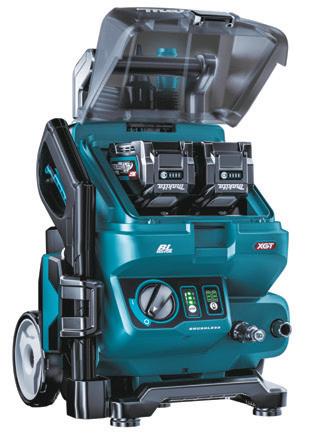
40V MAX XGT POWER WASHER: HW001G ACCESSORIES & ATTACHMENTS ALSO AVAILABLE













Discover the expansive XGT 40V and 80V Max line-up. With over 120 products and still expanding, the XGT range is your ultimate alternative to traditional petrol and mains power sources. Experience on-demand power across our complete product spectrum. Makita provides more than just power tools, explore our full range at makitauk.com and follow us on socials for updates.


Heavy duty powder coated steel construction with UDL rating of 800kg
4 Large sizes from 1500 x 750mm to 3050 x 1525mm. 900mm overall height.
Available with undershelf and roll dispenser options. Complete with Heavy Duty Castors
Available with 18mm MDF or Trespa options
Year Warranty
makitauk.com
115
40V MAX XGT CORDLESS POWER WASHER
BAR - 3 MODE - 7.0L/MIN
120+ FMJ.indd 1 19/04/2024 9:31 am Increase Productivity with Rhino Industrial Workbenches
ww w . rh ino cu t t i ng m a t . c o . u k
Designed and made in the UK. 5
FM CLINIC


The announcement in the Spring budget that the Government intends to introduce regulations for the providers of Environmental, Social, and Governance ratings illustrates an increased focus on managing environmental and social risks and building strong governance. With research suggesting the negative impacts of non-compliance on brand reputation, what are the main challenges for the FM sector in meeting ESG standards?
the cost to repair? How informed is the construction of new buildings, and how informed are the selections of equipment and installations in considering the impact upon your ongoing facilities management regimes and costs to maintain?
Building and equipment e iciency has never been more vital. Is the building fabric condition such that energy e iciency is maximised to its potential – increasing asset e iciency, and in turn saving money and reducing one’s carbon footprint.
This naturally becomes part of a wider assessment of your business - how can you operate, strategise and perform better. Because ESG and sustainabiity are all about asking questions of your method while asking you to improve.
In FMJ's regular monthly column, our team of FM experts answer your questions about the world of facilities management
THE ENERGY MANAGEMENT EXPERT’S VIEW
CHRIS NORTON, ASSOCIATE DIRECTOR, VISION ZERO CONSULT
ESG is a term now familiar to most of us – and sustainability is obviously a cornerstone of this. An organisation’s ESG is the standard by which its operations impact upon its stakeholders and wider society are assessed, while o ering transparency as to how that organisation performs across multiple levels.




Basically, sustainability should make people think, act and perform better – e iciency, decency and innovation. In a wider sense – as part of an ESG strategy, being to some extent an MOT for your business.
The announcement in the Spring budget highlights the drive in the FM industry to meet net zero. But this has to be part of a change in more fundamental mindset as to how buildings are built and maintained. Time is against us and being passive is not an option.
Asset Management demands equal consideration of Capex and Opex – How much a building costs to build is one thing, but with energy prices having spiked last year to 8x or 9x what it was 10 years ago, what about the cost in use and
Reducing energy usage saves money and reduces your emissions. Win win. But if an organisation also thinks about its employees, and considers building location – proximity to public transport, air quality, how pleasant the working environment is and the impact upon occupants’ wellbeing these are important – impacting upon morale, increased productivity and levels of sta retention to consider. These so er benefits become part of a company’s culture, and in turn its identity – increasing appeal to prospective employees and customers, as well as investors and shareholders. Good businesses making good business sense.
We have found that in working with clients to develop an ESG Strategy, underpinning what we do with a bespoke ESG IT solution means that you objectively assess performance, benchmark ongoing performance, and provide transparency to your investors, directors, employees, investors and your customers.
By doing this on a cyclical basis – establishing best practices as part of your business today routine, you can demonstrate your organisation’s ongoing excellence and a genuine commitment to meeting ESG standards.
THE BRANDING EXPERT’S VIEW
SARA BRACE, INTEGRATED ACCOUNT DIRECTOR, ONEAGENCY
As the Thomson Reuters report suggests, ESG compliance directly reflects a company’s values, leadership and reputation. This rings true for any business, from large blue chips to young start-ups, from essential service providers to product manufacturers. Whatever the size and shape of your
MAY 2024 20
ADVICE & OPINION
Chris Norton
company, you need to be visibly proactive when it comes to ESG e orts.
Visibility is the key word here. When implementing your business's integral ESG strategy, you shouldn’t underestimate the importance of also having a good marketing strategy running in tandem.

are doing in the public domain.



Two-thirds of survey respondents agreed their organisation has a duty to both stakeholders and society when it comes to addressing ESG issues. It is essential that progress is communicated not only internally, but to wider audiences too.
The research suggests internal communication of ESG successes is strong. Of those surveyed, 42 per cent said their companies issue annual reports or disclosure statements, 38 per cent include ESG progress into investor presentations, and 31 per cent conduct dedicated ESG briefings.
However, from the outside it can be hard to determine how a company is formalising its ESG obligations. Though ESG-related progression is really valuable to business operations, it is a wasted opportunity to not shout about the fantastic work you

How your business is perceived outside of your own organisational network is hugely influential, from recruitment to sales and beyond. But what does a strong public relations strategy look like?
Content is the beating heart of a good communication plan and our dedicated team works tirelessly to develop content campaigns that bolster a brand or business reputation. A large number of businesses already have this content in place, ripe to be transformed from internal communications to a public facing PR campaign.
In spite of that, a great strategy is about more than just promoting your business’s ESG successes in an isolated way. It should be about so much more than an ego-boost for stakeholders - a truly hard-working PR strategy will ensure your ESG content is of value to others too.
While it is of course beneficial to showcase your willingness and enthusiasm for ESG policy, if you can provide content that o ers advice and insights that will help others, you are much more likely to really engage outside influences with your brand or company narrative.
Format should also not be an oversight. Content marketing campaigns can be SO much more than words on a page. Yes, a press release still has merit but think bigger. Videos, whitepapers, infographics, interactive reports, online quizzes… the opportunities are endless!
We all need to consider our impact and support legislation that works towards a healthier planet and nurtured society. Taking proactive action to meet ESG goals is a priority, but don’t do it quietly. Don’t be afraid to showcase how proactive your business is, loudly celebrate your successes and take others on that journey with you.
THE FM SOFTWARE EXPERT’S VIEW
HAZEL BEDSON, DIRECTOR, SWG
Organisations are ramping up their commitment to ESG as part of a collective movement toward net zero and because the business case is becoming extremely di icult to ignore.




Strong reporting in areas such as carbon emissions can make all the di erence, especially in the context of more stringent regulatory compliance and increasingly demanding customers and investors.
The primary challenge for many is that the data crucial to supporting these e orts is o en out of date, patchy or plain lacking. A recent survey by BNP Paribas found that nearly threequarters of investors reported “inconsistent and incomplete” data as the biggest barrier to ESG investing. The lack of robust
MAY 2024 21 FMJ.CO.UK FM CLINIC
Sara Brace
ADVICE & OPINION
Hazel Bedson
FM CLINIC
data also makes the malpractice such as greenwashing more likely. This represents both a threat and an opportunity for the facilities management industry. FM has a pivotal role to play in ESG initiatives considering its influence across the built environment and other key business functions. To really lead, however, we need to take full advantage of all the technologies within our reach.
One key aim should be to have as much robust building lifecycle data as possible. Having visibility over the whole lifecycle, from design to operation through to disposal or refurbishment, would help organisations reduce carbon emissions, manage energy performance, and identify the impact of the materials used over the long term. In addition, it allows facilities managers to better understand their risk profile, gather the evidence for more accurate investment decisions in the future, and provide transparency for all stakeholders, including investors, tenants, communities, and regulators.



As such, facilities managers must consider the benefits of building information modelling (BIM). A collaborative way to share an uninterrupted flow of information across the building lifecycle, BIM serves as a digitised bank of highly valuable data that can support FMs in their ESG e orts. When combined with sensors that capture di erent factors such as occupancy and asset condition it becomes a single source of truth in real-time. As the World Economic Forum has written: “Organisations must ensure their data reflects realtime risks and regulatory developments. ESG data should remain relevant and timely and, ideally, should update automatically.”
When a company falls short against ESG criteria, it can damage its reputation in several ways. Firstly, clients and customers are becoming more conscious of the environmental and social impact of the products and services they buy. If a company is losing customers due to this it can hit their bottom line hard and reduce its market share.
Secondly, investors are increasingly factoring ESG performance into their decisions. They understand that companies with poor ESG practices may face regulatory fines, lawsuits, or other financial risks in the future, thus rendering them as poor investments. This will make it harder for the company to raise funds for future projects or expansions.


A primary challenge for the FM sector is ensuring compliance with ambitious targets set by organisations like the Science Based Targets (SBTi). The SBTi helps companies set emission reduction targets in line with the Paris Agreement's goal of 1.5°C by 2030.”






The result is a smart building, which represents the pinnacle of building management e iciency by providing FMs with the accurate, timely information they need to make better decisions around many key aspects of facilities management. What’s more, visibility uncovered by data is essential to FMs being able to perform their role as champions of ESG within the built environment, and the likes of BIM hold keys to unlocking the transformative potential of that information.
THE SUSTAINABILITY EXPERT’S VIEW
NATHAN GRAY,
HEAD OF SUSTAINABILITY AT RECONOMY
Companies are increasingly being judged not just by their products or profits, but by their actions. Environmental, Social, and Governance (ESG) has become a yardstick for measuring a company's commitment to sustainability and ethical practices. However, failing to meet or maintain ESG standards can have dire consequences for a company's brand reputation – which will inevitably lead to diminishing corporate performance.



Gray

NathanGray







Thirdly, employees are becoming more selective about the companies they work for. If a company's ESG reputation is tarnished, it may struggle to attract and retain top talent, leading to productivity losses and increased recruitment costs.
more selective about the companies
For the facilities management sector, meeting ESG standards on behalf of their clients poses unique challenges. FM companies are responsible for managing the physical assets and operations of buildings, including energy, waste, and maintenance. Therefore, they play a crucial role in helping clients reduce their environmental footprint, improve their social impact and operate e iciently.










A primary challenge for the FM sector is ensuring compliance with ambitious targets set by organisations like the Science Based Targets (SBTi). The SBTi helps companies set emission reduction targets in line with the Paris Agreement's goal of 1.5°C by 2030. Meeting these targets requires significant investments in energye icient technologies, renewables, reduced waste, and sustainable procurement. However, some FM companies may lack the expertise to implement these changes e ectively.
Another challenge is that of successfully navigating evolving regulations such as the Corporate Sustainability Reporting Directive (CSRD) in the European Union. The CSRD aims to standardise ESG reporting requirements for companies who have a foothold or operate within the EU, making it easier for investors and stakeholders to compare performance across di erent organisations. FM companies must stay abreast of these regulations and ensure that their clients' ESG data is accurate, transparent, and compliant with the legal requirements.
Ultimately, non-compliance with ESG standards can have serious repercussions for a company's brand reputation, a ecting its relationships with customers, investors and employees. The FM sector faces unique challenges in meeting these ESG standards on behalf of their clients, including ambitious targets set by initiatives like SBTi and regulatory requirements such as CSRD. Overcoming these challenges will require collaboration, innovation and a commitment to sustainability across the entire value chain.
Do you have a question that you’d like answered by the FMJ Clinic?
Email: sara.bean@kpmmedia.co.uk
MAY 2024 22
ADVICE & OPINION
Nathan
Safe Systems of Work & Technical Training for FM’s & Their Teams
We offer City & Guilds Assured courses and City & Guilds Qualifications covering all aspects of Mechanical & Electrical engineering and maintenance, including:
High Voltage
Low Voltage
Lifts
Ventilation
Fire Safety
F-Gas Handling
Legionella (Water Hygiene)
Electrical Installations
Confined Spaces & Working at Height
Medical Gas
Pipeline Systems
Mechanical & Pressure Systems
Aeronautical Ground Lighting (AGL)
Facilities Management
Technical Awareness


Available in York, Slough, Livingston & On-site at your premises

0333 121 0381 Call our team today fmj@ppltraining.co.uk go.ppltraining.co.uk/fmj visit our website
NEW FOR 2024 Steam Boiler Operator
Training for FM Contractors

SWEET SUCCESS


For the latest in our series of case studies on FM in extraordinary settings, Sara Bean took a tour of the British Sugar plant in East Anglia to see how the EMCOR UK team is embedded into the production process
Determining the contribution made by FM to the success of an organisation can, in the traditional o ice workplace scenario be di icult to do, but EMCOR UK’s partnership with British Sugar ably demonstrates the integral part facilities management plays in the success of Britain’s leading sugar producer.
As the sole processor of the UK’s beet sugar crop, British Sugar handles around eight million tonnes of sugar beet each year. This produces up to 1.2 million tonnes of sugar, which goes to half of the UK’s domestic sugar market and the British and Irish food and beverage sectors. The beets also generate a
range of other resources, including animal feed, topsoil, aggregate, liming products (fertiliser), bioethanol (used during the pandemic to produce hand sanitiser) and power generation.
For EMCOR UK, what began as a core so service delivery contract in 2010 has morphed into a 15-year contract to provide a series of services across the manufacturer’s plants. This includes delivering traditional so services such as cleaning, reception and security, and in a manufacturing setting, extends to encompass mechanical and electrical, conditioned based maintenance, grounds maintenance, pest control, and
tra ic marshalling of vehicles in and out of sites, all while meeting stringent statutory compliance standards, inspections and audits. More specialist services provided or managed by the EMCOR UK team include welding, industrial cleaning and sca olding. Explains Account Director Steve Thomson: “We cover around four and half million square metres in total for British Sugar, covering all four factories, one customer supply site, and all the considerable landscape across the sites. Even though we do the amenities, like reception and desk cleans, we are also out there in the factory and on every square inch of the plants. My
MAY 2024 24 CASE STUDY BRITISH SUGAR
operatives drive around on little diggers.
There are not many feather dusters in British Sugar.
“With, for example the heavy industrial cleaning we use high water pressure jetting which deliver pressures of 20 thousand per square inch, enough to cut you in half with the pressure lancers, so it’s a highly dangerous job.”
team is integral to running the core part of the factory.
“They understand us as a business, because the team puts an e ort into not only trying to understand what we’re trying to do but help us shape what we want to achieve, particularly meeting standards and compliance, so we work together very closely.”

they arrive at the



The EMCOR contract covers all five of British Sugar’s Bury St Edmunds (one factory and one customer supply site), Cantley, Newark and Wissington locations. FMJ visited the latter to see the partnership in action. Here the FM sta are highly involved in all aspects of the production process, from helping to process the raw beets when they arrive at the plant through to the ‘product intervention teams’ who are trusted to interact with the raw product before it goes into the bagging halls. Touring the extensive site which covers a multitude of buildings and processing towers it’s interesting to witness how entrenched the FM team is into the fabric of the production process.
ONBOARDING

Thomson describes the British Sugar journey as one of “evolution not revolution as it didn’t just happen overnight”. But as the contract has evolved, so too has EMCOR’s challenge in employing the right people to fill vacancies in what Thomson describes as a ‘destination site’ in the heart of the Norfolk countryside.
EMCOR UK has around 80 people on this site and British Sugar around 250 and it’s a highly automated site, so their team is integral to running the core part of the factory.”


and processing towers


Elliott Fisher, Site General Manager at British Sugar’s Wissington factory, commented: “EMCOR UK has around 80 people on this site and British Sugar around 250 and it’s a highly automated site, so their















job boards and through local agents and friends and family. One of the spaces we’re moving into are with charities, for instance a local council initiative Norfolk Boost and the Department of Working Practice. We’re also working with the Shaw Trust which helps ex-o enders trying to get rehabilitated into the workplace.
“We’re looking at all these opportunities to find our next talent bank because we’re in a really condensed market place.”

Prior to the contract, a persistent problem at the facility was the low recruitment and retention rate for FM employees.




“You must want to come to work here,” says Thomson, “so attracting recruits can be a struggle, because we’re competing with agriculture, of which there are a lot of jobs, for instance all the sugar beet processed at the site is grown within a 28 mile radius.
“This means we have to work really hard, using recruitment companies, posting on

Being miles from any café or co ee shop, on site catering is extremely important to the site, with Baxter Storey currently subcontracted to give “everyone the opportunity to have a really good meal”. All sta are paid the Real Living Wage and the cleaning sta who account for the majority of the contract are on four di erent cleaning ranges; from level one of cleaning o ice amenities to level four where sta use industrial mechanical cleaning equipment, are confine space entry and egress trained, and are responsible for cleaning tower sca olds and using the jet clean.
TRAINING AND WELLBEING
Given the inherent risks of working in manufacturing, new recruits go through rigorous onboarding site induction and training as well as a buddying programme. This is supplemented with a series of 12 mandated EMCOR UK training programmes – including asbestos management, COSHH training, high manual li ing, working in confined spaces and HAZMAT awareness. The FM team has even created its own bespoke accredited City and Guilds level 1 cleaning in a factory environment, course.
Supervision on such a complex site is also vital, so a set of seven di erent leadership courses have been developed
MAY 2024 25 FMJ.CO.UK BRITISH SUGAR CASE STUDY
site’

We’ve gone down a data route and the data we produce is absolutely essential in helping determine how our customer sees us because we’re giving them full transparency across what we do, where we doing it and why. It costs in everything being done, giving them access to a never seen level of information.”
in collaboration with EMCOR UK Learning & Development team that reward those who aspire to moving into supervisor roles. The team also delivers cross-functional training of all of the teams, which in case of labour shortages occurring means it can still deploy sta in key roles as required.
Another key preoccupation for Thomson is in monitoring the wellbeing of those deployed at the plants. In 2022, mental ill health was the second highest cause of absenteeism for EMCOR UK colleagues working at British Sugar, not terribly surprising given that males account for over 80 per cent of sta of which more than half are over 50 years old.
Says Thomson: “When I joined psychological safety was something you didn’t talk about and I simply couldn’t collude with that continuing so decided we’ve got to do something di erent. First, we launched an initiative, ‘This is us’ where I shared some really highly personal stu with colleagues on ‘these are the 10 things that impact me’. This helped to set the precedent and it started to build a bit of momentum.
“We then looked at how many mental
health First Aiders we had, and there weren’t any, now we’ve got 53, which means you’ve got 53 people trained in mental health signposting, of which eight are trained in more advanced analysis through a two-day mental health programme.
“Through our partnership with charity Access Community Trust (ACT) EMCOR UK sta volunteer at the Steam House Café in King’s Lynn, one of the charity’s mental health crisis cafes and we provide on-going drop in sessions at sites for all colleagues and customers.”
These initiatives have resulted in a 50 per cent reduction in the number of working days lost by EMCOR UK colleagues working at British Sugar due to mental health issues.
Given the physical demands of the job, health and safety remains a huge priority but so too do physical health checks. Just the day before our visit onsite wellbeing checks with AXA healthcare on blood pressure and heart health culminated in two members of sta being referred to their doctors.
MEASURING PERFORMANCE
While there are a host of day-to-day activities where the FM team proves its’ mettle, for instance in tackling spillages, which in a manufacturing setting can halt production, leading to escalating costs, data analysis has become a key way of measuring performance.
Explains Thomson: “We’ve gone down a data route and the data we produce is absolutely essential in helping determine how our customer sees us because we’re giving them full transparency across what we do, where we doing it and why. It costs in everything being done, giving them access to a never seen level of information.”
Developed by EMCOR UK’s Senior Business Analyst Jo Petch, the system uses a combination of so ware, from Fusion Smartsheet to Power BI, and using a ‘clever bit of coding’ enables operatives to record every process, which is then translated into a full report on the condition of all areas of the site. For example, the sca old manager carries out a sca old check once a week on every sca old. By automating this he records the condition online and by pressing a button creates a dashboard which shows which new sca old has been put up, who created it, and whether there are any defects. So far, 18 operational dashboards have been created that provide data and insights into whole swaths of the sites.
Says Thomson: “All that information is there for the customer to see, who then doesn’t have to chase us up to check on it. In the longer term we’re planning to go virtually paperless by automating as much of these processes as possible.”
Fisher from British Sugar agrees with the usefulness of this approach: “We are a data rich business but you need clarity in that data so as to create insights to determine what it is actually telling you. We’ve gone on a big journey with that and the FM team has done this in parallel. For example, they will capture where we’re getting a number of spills, and that data will then let us put in an improvement procedure to prevent that happening in the future. This directly a ects their productivity and raises factory standards.”
With the contract coming up for renewal within the next 18 months, Thomson reports having some really positive discussions on a contract extension and says going on ‘a data quest’ is helping both parties make this huge decision, especially with the current incumbents so embedded into the production processes.
As he concludes: “This kind of contract requires very specific FM people working within a manufacturing scenario because it’s so di erent. I’ve seen how commercial o ices are run by FM, and this is a whole new ballgame, it feels so much more important.”
MAY 2024 26 CASE STUDY BRITISH SUGAR











Dependable Door Control Solutions




www.doorcontrolsdirect.co.uk 01305 263300 sales@doorcontrolsdirect.co.uk
At Door Controls Direct, we understand the unique requirements of the fire safety and building industries, and we provide a wide range of fire-rated and compliant products to keep people safe and secure. www.doorcontrolsdirect.co.uk Door Controls Direct, your dependable source for door solutions that will keep people safe and secure.
EASY WINS ON WASTE





Helen Bentham, TWM Contracts Manager at waste management company CSG, explains how small changes to waste disposal practices can help facilities managers hit ESG targets



Facilities managers are under pressure to consistently reduce the carbon footprint of their businesses as they push towards net zero targets. Frequent changes to environmental legislation are also proving di icult to keep on top of, leaving some facilities managers confused and frustrated. Many businesses try to meet ESG targets with large-scale projects such as solar panel installation or switching company vehicles to electric.

Yet facilities managers who are struggling to hit increasinglychallenging ESG goals are missing out on quick, easy wins to boost their sustainability credentials. For instance, waste disposal is o en overlooked or put to the bottom of the list, yet small changes can have a huge positive impact on a business’ overall ESG rating.
The waste a business produces will depend entirely on its operations. In a manufacturing operation, it could be hazardous waste like chemicals or oils. For the majority of other businesses, it’s likely to be day-to-day waste more akin to household waste like

paper, packaging or food.
WASTE PRINCIPLES
Whatever the waste, the principles are broadly the same – firstly reduce the amount of waste being produced, secondly reuse or recycle as much as possible and, finally, dispose of anything else in the most e icient and environmentally-friendly manner possible.








As one of the country’s leading waste management experts, CSG can o er a waste auditing service to unearth exactly what waste a business is creating – and how it can improve.
One of the first changes we always suggest is to dramatically reduce the number of waste disposal vehicles leaving the site. To achieve this, it’s vital that every single vehicle is operating at its maximum payload. This is just one of the many quick, easy wins facilities managers tend to overlook.

MAY 2024 28 FOCUS WASTE MANAGEMENT

One of CSG’s partners is AESC UK, an international net zero technology partner supporting a diverse range of industries. Its state-of-the-art facility in Sunderland produces electric vehicle batteries for the UK automotive industry. The business employs more than 470 people and rapid expansion has led to the construction of a second plant, also in Sunderland.
PROBLEMATIC WASTE STREAM
We were first introduced to support AESC UK with a problematic waste stream. It was proving di icult to remove this from the site in a cost-e ective way due to limited available outlets. Our hazardous waste treatment team met the challenge head-on and was able to find a safe and compliant solution whilst minimising the costs for AESC UK.
Firstly, we audited all waste streams arising from the site. Suggestions around waste labelling and categorisation were implemented to improve safe handling and segregation.

their sustainability objectives.
HAZARDOUS WASTE STREAMS
Another of CSG’s long-standing partnerships is with Safran Landing Systems, the world’s leading manufacturer of aircra landing systems. CSG is responsible for the collection, recycling and disposal of all day-to-day waste generated on Safran’s 27-acre Gloucester site, including over 20 hazardous waste streams.
With a team of four waste experts based at Safron’s site five days a week, the proportion of wasteincluding hazardous - being diverted from landfill is now 98.72 per cent. Dry, non-hazardous waste is 100 per cent zero-to-landfill.
Another of CSG’s largest clients produces a significant amount of waste wood. Rather than sending the wood from site as waste, CSG implemented a change to make the wood into briquettes, which are sold as fuel.

Certain hazardous waste streams were being sent for incineration which, like landfill, is classed as a disposal activity. CSG’s trans-frontier shipment service exports hazardous wastes with an energy value to Europe for recovery in energy from waste (EfW) facilities.






Hazardous
Hazardous EfW outlets are not currently available in the UK. We arranged for AESC UK to have priority access to hazardous EfW via limited transfrontier shipment routes. This means that all hazardous waste from the facility is now diverted from disposal in landfill or incineration.





A review of recyclables also revealed room for improvement. Using extensive industry contacts, CSG was able to source new outlets for cardboard and various plastic waste streams. As a result, this increased recycling rebates by 224 per cent when compared to 2022.
Proposals are also underway to improve segregation in the site canteen using a coloured bin system with enhanced signage. Waste from the canteen will be properly segregated, with food waste going to anaerobic digestion for energy recovery. AESC UK employees will receive a toolbox talk about any new system to ensure buy-in and understanding.
A review is also underway to replace the current site portapacker with a static compactor unit. More e icient compaction will reduce skip exchanges, therefore reducing transport costs and carbon emissions resulting from the site emissions.
AESC UK’s waste management previously came under a broader facilities management package. They had various points of contact for di erent waste streams and it was di icult to manage and monitor. They felt, rightly, that a greater, more concentrated approach to waste was needed to help bring about

EfW outlets are not currently available in the UK. We arranged for AESC UK to have priority access to hazardous EfW via limited trans-frontier shipment routes. This means that all hazardous waste from the facility is now diverted from disposal in landfill or incineration.”
Waste management companies will produce tonnage data on the amount of waste recovered, which help facilities managers to produce the reports they need to demonstrate progress within their organisation. While the environment should be the number one priority of any waste management strategy, it is also common for there to be a reduction in business overheads and increased profitability as a result of changes.



facilities managers to produce






there to be a reduction increased profitability as a







Businesses can improve their bottom lines by four or even fivefigures with simple, overnight changes, via a waste mapping team that will visit a new client and determine where waste streams can either be reduced or, even better, completely eliminated.
figures with simple, overnight changes, via
Facilities managers shouldn’t underestimate how much of an impact seemingly small changes can make. For one of our major customers, we reduced the number of internal bins by 27 per cent. This not only encouraged colleagues to segregate their waste better but also saved £2,000 a year in bin bags alone.
We know that facilities managers are under pressure and have very wide remits. Appointing waste professionals can make a huge di erence and free up time to concentrate on other priorities.

MAY 2024 29 FMJ.CO.UK WASTE MANAGEMENT FOCUS
SOLID SOLUTION
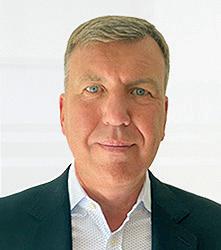
As waste disposal costs increase, Lee Knott, the Chief Executive of biotechnology business Advetec explains the benefits of turning non-recyclable waste into Solid Recovered Fuel (SRF)
Facedwith the onerous responsibility of Scope
3 emissions reporting and an ever-increasing need for the highest levels of environmental governance, facility managers must become more knowledgeable about the waste their organisations and supply chains create.
This is particularly timely as the waste industry is facing seismic change. The increase in Landfill Tax, as set out in the Spring Budget, is just one of the latest moves to drive more responsible waste practices. It’s coupled with more change on the horizon, too, including the decision to halve the amount of residual waste sent to landfill or incineration by 2042 and news that Energy from Waste (EfW) incineration will incur carbon emissions penalties from 2028 as it becomes part of the Emissions Trading Scheme (ETS).
These changes mean that traditional waste disposal will become much more expensive. For facilities teams striving to lower costs and improve their green credentials, measures such as scrutinising supply chains, encouraging greater recycling and moving to green energy will not su ice; they’ll also need to push for more innovative and cost-e ective solutions from their waste handlers.
While some of these deadlines may seem far o , they don’t leave much time to navigate the sector’s significant changes. In 2026, EfW costs will likely rise to subsidise necessary technological changes, so the sooner facilities professionals and their waste partners investigate alternatives, the better the
chance of a smooth and cost-e ective transition.
COSTS WILL GO UP, NOT DOWN
As the Chief Executive of biotechnology business Advetec, which turns non-recyclable waste into Solid Recovered Fuel (SRF) I believe all of these changes are meant to make old waste habits undesirable and to drive positive change. The upshot is that sending waste to landfill or incineration will get much more expensive for waste handlers. Very few will be able to absorb these costs, so they’ll be passed on to customers and eat into FMs’ budgets.
The 20 per cent increase in Landfill Tax will make landfill a costly form of disposal, and it’s intended to push people more to incineration. But they’ll be caught with cost increases there too, as the Emissions Trading Scheme will see EfW operators taxed in relation to their carbon emissions. In turn, this will increase the cost of EfW for customers.
Under the ETS rules, which will a ect EfW from 2028, the price per tonne is expected to be close to £170. That will comprise £100 for disposal and £70 tax.
The ETS is intended to combat climate change and reduce greenhouse gas emissions cost-e ectively, and it’s already in use across Europe. It’s likely that the cost of landfill will increase even further in the UK to ensure that EfW, even with the he y price hikes from ETS, is the more a ordable and, therefore, used disposal route. Tax on carbon emissions is here to stay.

However, EfW isn’t the only option. More work is needed to educate organisations and FMs about the potential of their waste and, crucially, that alternative, more innovative, and financially favourable disposal routes already exist. Cost increases don’t have to be inevitable. The real opportunity is for the facilities community to exert their power and demand more innovative solutions from their waste handlers.
EMBRACE INNOVATION
Solutions such as Advetec’s biotechnology divert 100 per cent of non-recyclable waste previously destined for landfill or incineration and turn it into SRF, which also opens up other o ake routes. It can be used as a coal replacement product to help heavy industries decarbonise, like cement manufacture. It’s also well suited for other uses, such as gasification, further segregation and recycling, and conversion into hydrogen to power cars and plants
As large-scale industries like cement production seek to decarbonise, demand for fuels like SRF increases. This is because SRF has a high proportion of biogenic carbon—which is not subject to the Emissions Trading Scheme.
Historically, smaller waste handlers have not pursued SRF creation as they’ve struggled to achieve the volumes, consistency and quality of waste required to meet SRF o -taker’s’ rigorous standards. Others simply did not know that SRF o ake was an option. Consequently, many facilities professionals have had little knowledge of it too.
Thankfully, the discussion around the waste is reaching fever pitch, and there’s a strong appetite for change. The UK’s landfill assets are almost at capacity, and the cost of EfW is rising, so there’s a growing acceptance that we must embrace other methods. More recycling is certainly part of that picture, but increasing the investment and infrastructure required will take time. One of the quickest ways to drive positive change now and lower costs and carbon is by turning non-recyclable waste into a commodity such as SRF.
As waste operators try to make sense of new legislation and rising costs, FMs can expect to share some of that pain, unless they set about investing in their waste knowledge. The more they know about the waste they create and the potential of those streams, the more they can demand of their waste partners and reap the benefits of reduced carbon and costs.
MAY 2024 30 FOCUS WASTE MANAGEMENT



Be more efficient
Be more effective


Be more compliant
Be more Asckey
Build a tailored FM application that has the flexibility to grow with your business.







Discover more
FUTURE OF CLEANING

The British Institute of Cleaning Science (BICSc) and the Cleaning and Support Services Association (CSSA) have announced an initiative in partnership with the University of Surrey to explore innovation in the cleaning industry. FMJ reports

In January, a joint initiative between BICSc and the CSSA into the ‘Future of Cleaning’ was launched to help determine the impact that machinery, including IoT sensors, robotics, and data collectors are having on the process of cleaning.
As part of the initiative, various trials are taking place on the University of Surrey campus, which was selected because the majority of its current cleaning processes are conducted manually. According to Paul Ashton, CSSA Chairman, the objective is to understand how the latest technology and innovations are impacting on cleaning regimes in real terms.
The study also aims to understand what di erences in training needs will be required when introducing these technologies to the cleaning community. Denise Hanson, BICSc Commercial Director, who is an expert in technical cleaning, and Dr Andrew Kemp, alongside the BICSc Scientific Advisory Board, are heavily involved in the ongoing research project.
Explaining the rationale behind the initiative, Hanson says: “There has been a huge increase in the technology available to the cleaning industry and while each supplier claims the e ectiveness of their kit, there has been little independent validation to date on these claims.
“BICSc produces productivity ratios for the cleaning of di erent buildings and to remain up-to-date and valid these rates need to incorporate relevant time saving technologies.”
She believes the research is important as it represents independent validation of manufacturers’ claims. The trial has been set up to allow the manufacturers to choose campus areas where they feel they can make an impact and then look at what they achieve, compared to their general equipment claims.
The leading suppliers taking part are Numatic, Birkin, ICE – Industrial Cleaning Equipment, Killis, Diversey, Kärcher, Orion Eco Solution, and Safer Spaces.
These manufacturers were given the opportunity to walk around the university and choose where they felt that their equipment could make the biggest di erence. The key areas identified were the university’s sports centre and the vets’ school.
Explains Hanson: “The equipment that the participating manufacturers are supplying is cutting-edge and among the latest options available in the industry.
“We have cobotics, robotics and later into the trial there will be microfibre and there will be product and antibacterial coatings. So, we are looking at a range of di erent solutions to cleaning issues and productivities.
MAY 2024 32 FOCUS HYGIENE
“Being an independent, standalone study makes this important to the sector and there will be learnings about where equipment works best and where it fits.”
HOW THE TRIALS TAKE PLACE
Because the trials will take place in set areas on the university campus they can be judged like against like. The suppliers will then outfit these areas with their recommended ranges and train the operatives in their utilisation.
Each trial will run for a six-week period and the areas will be audited for their cleanliness on both the start and the completion of the trial period, with operatives also being questioned for their views on the kit and its e ectiveness.
Air quality samples will also be taken at each trial, for both pre and post cleaning, to check any manufacturer’s claims that their machinery delivers better air quality. Swabs will also be taken in the test areas to check the bacterial counts both pre and post trials.
Says Hanson: “We are also carrying out audits via the BICSc Audit App at the start of each trial and at the end of each trial. As it will be the same auditor throughout the trials, which will be myself. We will have qualitative standards, which means we are not explaining to the sta what’s wrong during the trials.
“The trial will be looking at the robustness and reliability of the equipment provided, which will be part of the information we gather from this project. Each trial will clearly show the cleaning standards achieved and the productivity of each manufacturer and their o er against the standard ratings.”
TRAINING FACTORS
One of the key purposes of the research is to provide clearer guidance to the sector regarding skills and training for cleaning operatives. For this reason, the manufacturers are putting together the relevant training packages for their range and the operatives will be asked questions regarding the e ectiveness of this training.
Says Hanson: “In addition to this, at the end of this project, it is our intention to then provide BICSc training for the operatives. We want to add six weeks at the end - where BICSc will train the sta and they will be audited and inspected every week to see what impact that has to the standard.
“We are there at the end of the project so that we are not impacting on anyone’s trial with the training that BICSc will provide. We will train the sta for each area and on the skills that are required. What will be key at the end of this is to then be able to say

BICSc has now trained the sta , we are inspecting weekly, giving feedback to the sta , this is what that process does and what the results are.”
Hanson is confident that the initiative will help to demonstrate how important correct training is to the sector.
She says: “While you can train operatives on how to use the equipment provided, my argument will always be that unless you train operatives to physically do the skills, you are not training them properly.
This [study] will be looking at what di erence skills training makes. We will also show the usability of the kit from the cleaning operatives’ viewpoint.”
While you can train operatives on how to use the equipment provided, my argument will always be that unless you train operatives to physically do the skills, you are not training them properly. This [study] will be looking at what di erence skills training makes. We will also show the usability of the kit from the cleaning operatives’ viewpoint.”
In practice this means that any initial training is provided by the manufacturer who is providing the machinery being utilised as part of the trials. In this way, if the machinery supplied does everything the manufacturers say it will do, the operatives should have more time to spend on key areas that need more thorough attention, which is the whole basis of the cleanliness audit.
“The quality of the training will be key and that the kit is fit for purpose for the areas selected. This should include an explanation to the cleaning operatives of the machines being o ered.”
Because the team wanted to give equal opportunity to every manufacturer the trial will run until May 2025, to allow the summer holidays and the Christmas break to ensure that everyone has a six-week period of term time. Reports will then be produced covering air quality, bacterial count, and cleanliness audits. Concludes Hanson: “We are trying to drill down into the actual specifics, what does this equipment clean in the allocated times and to what level?
“Though this study, we should get some good data of where the kit provided fits and where you’ll reap the maximum benefits from it.”
MAY 2024 33 FMJ.CO.UK HYGIENE FOCUS





APPLIANCE OF SCIENCE
Dominic
Folliss
of Churchill describes a science-led approach that explores best practice hygiene processes, something of particular relevance for flexible
It seems that every week there is a new report about the future of the workplace, veering from a full return to the o ice to predictions that remote working will become the norm. The truth probably lies somewhere in between as companies find a solution that suits them, which is o en a hybrid arrangement. As such, flexible o ices will have a big part to play in the years ahead.
I recently held a webinar with the Flexible Space Association (FlexSA) to discuss FM trends and tools. It’s a competitive space and operators need to create workplaces that o er more than the home or local co ee shop if they are to attract businesses.
Technology can help these spaces to automate processes, improve the user experience, provide valuable data and assist with smarter space optimisation. The emergence of AI is helping to identify trends, predict future scenarios and o er possible solutions. It’s critical to purchase and implement tech in a strategic way with a clear view of the business objectives that it will support.
Consider five of the core FM functions – cleaning, security, waste management, guest services and the user experience. Occupancy sensors can provide data that will inform space management, and therefore the user experience, but can also be used by cleaning teams so they can allocate their resources more e iciently.
Similarly, visitor management systems can be adopted by guest services so that teams can spend more time on other valuable tasks, while security teams benefit from these systems for the same reason.
HYGIENIC WORKPLACES
Above all else, whatever the size and type of
workplace, hygiene remains the top priority. Organisations have a duty of care to their employees and those employees have a higher expectation than ever about the level of hygiene in the workplace.
We have launched a white paper on the topic that is relevant to all FMs, property managers and flexible space operators. The backbone of this paper was a science-led study that explored two key components of workplace hygiene – the presence of harmful microorganisms (pathogens) on surfaces or in the air, and the indoor air quality.
Pathogens are easily transmitted through the air, via surfaces or direct contact such as a handshake. While we hope we don’t have another COVID situation anytime soon, colds and viruses can still cause a lot of illness, which leads to lower productivity.
It is particularly important for FM professionals to understand the bacteria and viruses that are present in their buildings. If they are able to identify potential risks, they can take proactive measures to mitigate them.
TVC SWABBING
Total Viable Count (TVC) swabbing tests the level of bacteria present on a surface. An e ective TVC swabbing programme can identify areas of higher contamination, which gives cleaning operatives data-backed insight into the areas that require more attention. Common areas with a higher TVC count include door handles, li buttons, bathroom doors and fridges. This varies by workplace and the beauty of a science-backed approach is that you are removing all the guess work from your cleaning regime. Cleaning schedules can be adapted as needed and operatives can focus on where they are needed the most.
INDOOR AIR QUALITY
workspaces
The two environmental parameters that are most likely to have the biggest impact on microbiological contamination are temperature and relative humidity. Controlling these is all about balancing the risk of transmission with the comfort of occupants. We partnered with AirRated, a company that provides certifications for Indoor Air Quality (IAQ), to conduct a Proof of Concept trial that explored a possible link between levels of microbial contamination and poor IAQ conditions. This was conducted at a Legal & General Investment Management shared o ice space with a capacity of 1,000 occupants.
The research identified that both relative humidity and temperature had an impact on the growth of airborne microorganisms and surface contamination. Using our workplace hygiene tool PRISM, we were able to analyse the data to identify “hot spots” so that state of the art technology and enhanced hygiene programs can be installed to minimise the hazard.
HYGIENE AS A TOP PRIORITY
The importance of hygiene extends beyond the fundamentals of protecting the health of building occupants. Poor hygiene can impact business reputation, stifle productivity and even make it harder to attract and retain talent.
A science-led approach is imperative because businesses can make informed decisions about cleaning protocols and demonstrate the impact to their employees with hard data. A commitment to prioritising health and wellbeing will not only protect employees and building users, but will contribute to the long-term success and resilience of the business.
MAY 2024 34 FOCUS HYGIENE









LEADING FROM THE FRONT
Matt Chapman, CEO at SBFM explains why the soft services supplier is keen to share its blueprint for better communications with front-line workers













Last year, a report commissioned by Legal and General into ‘hidden workers’, in particular cleaners and security sta , revealed disparities in their health and wellbeing compared to white collar sta . It was a similar story in an international survey of cleaners, commissioned by UNI Global Union, which found that working unsocial hours had adverse impacts on physical and mental health.

Given that these workers form the backbone of FM services, the facilities management sector is being urged to acknowledge these issues and work together to make improvements. At the Workplace Futures conference in February it was heartening to hear Matt Chapman, CEO of so services provider SBFM share ideas on ‘a blueprint for connection’ to these vital workers who he said, are o en referred to disparagingly as “just a cleaner”.
Chapman, who has long campaigned for increased diversity and opportunity in the FM sector has applied his considerable passion for people to his CEO role at SBFM, which he joined from Atalian Servest in 2022. Founder, Colin Shute, started the company 10 years ago.

Explains Chapman: “Colin had heard of the things that I’d been saying about the industry for years, and wanted to give me a platform to actually implement all these ideals and ideas that we tend to put in documents and don’t always get around to doing.
“We agreed as a board that we wanted to do something which promotes sustainability in a sector where traditionally there has been too much of a race to the bottom. This is why we steered the ‘SB’ in SBFM towards a Sustainable Business proposition. One that also attracts people to our industry.
“This means we want to price contracts properly and use our technology to help people deliver their jobs and excel in their careers. It is also about creating an inclusive environment where at SBFM, we have even provided options of comfortable workwear that allows colleagues to wear SBFM branded hoodies and T-shirts if they want to, instead of the tradition of formal workwear.”







The changes extend to the company’s business strapline – ‘Reimagining FM for people and places’, and the publication of the SBFM key values, which are, ‘be a good person, play as a team, think di erently and make an impact’.
Says Chapman: “Now I’m very pleased to say that everything from the talent we attract, how we appraise our people to how we roll out our technology fits those four key values.”
MAY 2024 36 FOCUS INTERVIEW
RECRUITMENT OPPORTUNITIES
One of the priorities is in meeting the recruitment challenges of a notoriously undervalued workforce which as Chapman admits, “looks bad compared to other industries where people get paid the Real Living Wage or above and get a lovely o ice environment”.
He believes the sector is asking the lowest paid people to deal with some of the hardest jobs that no one else wants to do. Chapman’s own family experiences have made him a huge advocate of opportunity for all. His parentless mother Beverley was working by the age of 14 in a hotel in Montego Bay, Jamaica, where an American visitor was so impressed with her competence, he paid for her to attend a private girl’s school which culminated in her move to England as one of the nursing bastions of the NHS.
Says Chapman: “My purpose is to ask, how many more Beverley’s can we help? We’ve got a workforce and what we’re saying is ‘we will give you visibility and with our platform we’ll help you feel seen. We’ll upli you and empower you to get to the next level, hopefully with us, but if not with our clients’.”
Appealing to a wider job pool is both an essential way to find much needed sta but it also fulfils the company’s ambition of giving people from disadvantaged groups equal opportunities. Last year the company launched Evolve, a new initiative dedicated to providing sustainable employment opportunities, increase the earning potential of ‘hidden workers’, and help widen the talent pool.
“It’s driving purpose is to make people’s lives better,” says Chapman. “It is a model that is already delivering results, with several ex-o enders and care leavers working as cleaners at PureGym while

receiving free training to become personal trainers.
“Another of our clients, the multinational cra brewer BrewDog struggled to get bar sta but with their sta paid a pound more than cleaners some of our people that show potential have been given the opportunity to join the BrewDog brand.”
Chapman is also using his influence to encourage the sector to encourage a more diverse representation within organisational cultures of gender, race, self-identity

and neurodiversity.
He says: “While FM suppliers may boast that their workforce represents countries from around the world, when you look into the baseline versus the leadership, it remains primarily white middle-aged men.
“I would like to see a real change culturally and this needs to be embedded into each organisation. Being very cognisant of male to female ratio at our management level we’ve just got a new operational leadership team and there are six females to five males on the team from all di erent walks of life because we feel they convey our values.

I would like to see a real change culturally and this needs to be embedded into each organisation. Being very cognisant of male to female ratio at our management level we’ve just got a new operational leadership team and there are six females to five males on the team from all di erent walks of life because we feel they convey our values.”
“Also, there needs to be more recognition that many of us are divergent. My son has autism and is super clever and I want to see him get every chance to excel in the workplace. For myself, I’ve been diagnosed with ADHD, my brain overworks and I have to take some measures but I’m also fuelled with ideas, so I want to see more understanding of the power of neurodivergence.”
TECHNOLOGICAL SOLUTIONS
Another huge issue for front-line operatives is in feeling isolated from the organisations that employ them. For Chapman, this is where technological innovation can play a positive role. SBFM’s award winning system Optimise-AI picked up the 2024 i-FM
MAY 2024 37 FMJ.CO.UK INTERVIEW FOCUS
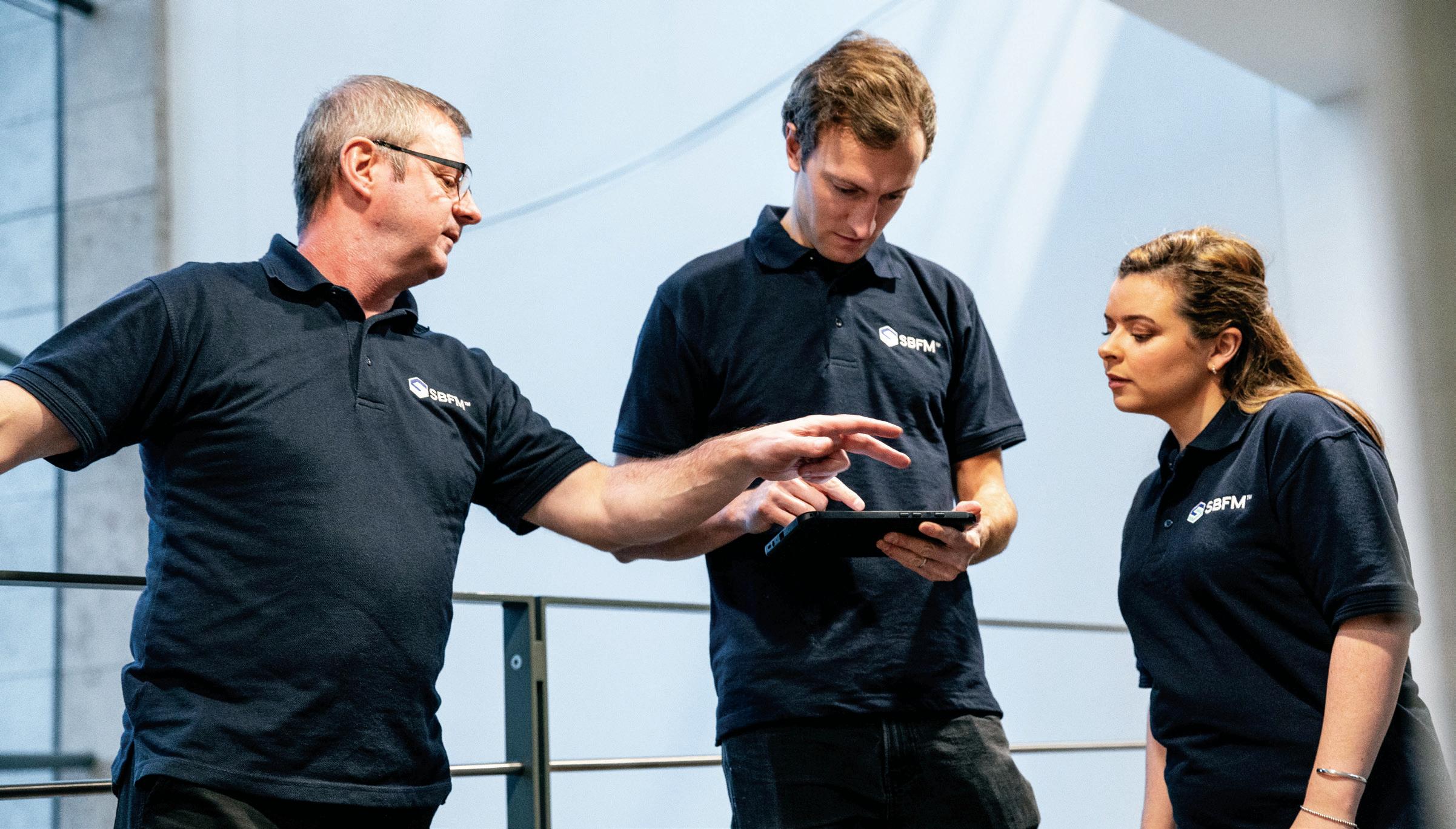
Despite the fact we’re an emerging company we get asked, ‘can you do our cleaning, catering and security?’ It’s because they like the personality and the feel of the business, the ethical approach to the supply chain and the data aggregation that is our tech.
Technology in FM Award for its ability to use SBFM data to help answer day-to-day questions from its 7,000 sta .
This people-centric approach goes to the heart of his philosophy and has helped create a community of workers, who, coming from multi-ethnic backgrounds may not be good English speakers. Developing the system, SBFM’s CTO Ricky Majer allowed for the fact that for many of the sta , there is not only the physical barrier of being based in di erent locations from their managers, but a language barrier as well. Optimise-AI is designed to be multilingual, so users can type in a question in any language and it won’t just give them an answer in their chosen language, but is shown in English as well, which helps nonEnglish speakers improve their skills.
Says Chapman: “Psychologically it also helps alleviate the pressure on cleaners as the reality is they’re probably not going to hear from their manager every single day, so if they need a quick-fire answer to something like ‘can I book my holiday?’ they can do that via AI so are not le just waiting for a call back.”
This may certainly help to address the isolation felt by many front-line workers. Other innovations in the firm’s

technological toolbox aim to help counter the di iculties many cleaners reported in the ‘hidden figures’ report of having to travel miles to some jobs.
Says Chapman: “Our dashboard tells me where the shi is and we can measure the average distance people might go which is 10 kilometres. And we also can add in an extra payment to cover a shi further away, and even tell them the bus route. It means we have a metric of how far a person needs to travel.
“Alongside this, when someone leaves we use a telecoms organisation model to ask ‘why are you leaving, and can we persuade you to stay?’ If the answer is still no the third strand is ‘why don’t you keep in touch?’
“In this way we’ve amassed within this industry a 100,000-person database of people who worked for us who had a good experience. This means if a person does not turn up to their shi the system pushes it out to people based in that area and based on their star rating, their safe to work status, previous attendance and reliable audit scores, it then alerts them of a potential shi .
“This is cost e ective because the client is getting the shi covered, and the system
will also find out why the original person did not turn up in the first place, and it provides extra income for the attendee, so everybody wins.”
FUTURE PLANS
While around 90 per cent of SBFM’s services are in cleaning the company has expanded into providing other services over the years, particularly in security, waste management, catering and pest control as clients who’ve been impressed with the firm and the tech proposition have asked for the delivery of other so services.
Says Chapman: “Despite the fact we’re an emerging company we get asked, ‘can you do our cleaning, catering and security?’ It’s because they like the personality and the feel of the business, the ethical approach to the supply chain and the data aggregation that is our tech.
“For the future we’re looking at more positive collaborations, for instance client BrewDog wanted to work with us as a partner and supplier. Because they wanted to do something di erent, they have put our logo on their cleaning equipment as part of their DNA. Now because their consumers all love the BrewDog brand, they want to purchase a BrewDog vacuum cleaner.
“Alongside this we will continue developing our technology and help our front-line colleagues feel they can achieve anything they want to, by matching the competition with innovations that make a positive impact on this sector.”
MAY 2024 38 FOCUS INTERVIEW





36524/7DAYS A YEAR
Confined space entry to deep manholes, tanks etc.
CCT
High
High reach remote access & gutter/roof cleaning etc.
Chemical
Chemical

Located in Ongar, Essex, United Drains seeks an adept Sales Manager to fuel its growth. This full-time, permanent role boasts competitive earnings, including an OTE exceeding £100,000. The successful candidate will spearhead business expansion, managing a small sales team to cultivate client relationships and drive sustainable financial growth. Essential requirements include a minimum of 10 years' B2B sales experience, with a background in Facilities Management, exceptional communication skills, and proficiency in Microsoft Office and CRM systems like HubSpot.
Responsibilities
Responsibilities encompass leading the sales team, conducting regular meetings, and actively participating in strategic planning sessions. The role demands meticulous attention to detail, exceptional leadership, and a proactive approach to new business development. United Drains offers promising career prospects, flexible working hours, and a vibrant company culture, inviting qualified candidates to join its journey to success
WE’RE HIRING!
in Ongar, Essex, United Drains seeks an adept Sales Manager to fuel its growth. This full-time, permanent role boasts competitive earnings, including an OTE exceeding £100,000. The successful candidate will spearhead business expansion, managing a small sales team to cultivate client relationships and drive sustainable financial growth. Essential requirements include a minimum of 10 years' B2B sales experience, with a background in Facilities Management, exceptional communication skills, and proficiency in Microsoft Office and CRM systems like HubSpot.
Located
encompass leading the sales team, conducting regular meetings, and actively participating in strategic planning sessions. The role demands meticulous attention to detail, exceptional leadership, and a proactive approach to new business development. United Drains offers promising career prospects, flexible working hours, and a vibrant company culture, inviting qualified candidates to join its journey to success 020 info uniteddrains.co.uk uniteddrains.co.uk 365 DAYS We are bec ming t e U ’s leading drainage & plumbing specialists 24 hour emergency call out cover Preventative Planned Maintenance (PPM) Specialist high pressure water jetting & electro mechanical coring techniques Excavation & repairs, lining & other in-situ pipe repair technology Specialist combination & vacuum tanker work Pumping station maintenance, repair & installation Confined space entry to deep manholes, tanks etc. CCT surveys, full structural/service reports & underground service detection
reach remote access &
cleaning etc.
gutter/roof
dosing systems & grease trap installation VOTED SOUTH EAST’S BEST DRAINAGE COMPANY 2023 FACILITIES SALES MANAGER WE’RE HIRING!
020 info uniteddrains.co.uk uniteddrains.co.uk
We are bec ming t e U ’s leading drainage & plumbing specialists
hour emergency call out cover Preventative Planned Maintenance (PPM) Specialist high pressure water jetting & electro mechanical coring techniques
repairs, lining
other in-situ pipe repair technology
combination
vacuum tanker work
24
Excavation &
&
Specialist
&
Pumping station maintenance, repair & installation
surveys, full structural/service reports & underground service detection
VOTED SOUTH EAST’S BEST DRAINAGE COMPANY 2023 FACILITIES SALES MANAGER
dosing systems & grease trap installation

KEEPING YOUR GROUNDS AFLOAT

Karl Cundill, Joint Managing Director at LitmusFM, looks at proactive maintenance plans that can be implemented to reduce the risk of grounds flooding
The UK is experiencing increased rainfall, with the past 18 months being the wettest England has seen since records began in 1836. Many climate scientists have warned that this is becoming the norm, with climate change exacerbating weather events, creating both warmer and wetter conditions. As climate change results in more frequent, and heavier, rainfall and drier summers, this brings many new challenges for grounds maintenance.
Significant levels of rainfall and flooding have a detrimental impact on grounds
and landscaped areas, with garden plants dying as a result, sporting pitches becoming unusable, outdoor seating areas becoming waterlogged and school grounds having to close completely – the list goes on. Waterlogged outdoor areas, along with ill-maintained gutters, downpipes and drainage systems, increase the risk of water levels rising to the point they potentially flood adjoining buildings.
For FMs this poses new challenges, and the need for more robust, long term grounds maintenance plans to help reduce the risk of flooding and damage.
PROACTIVE APPROACH
It may sound simple, but the key to managing the increased rainfall we’re experiencing is ensuring a proactive maintenance regime is in place. The grounds should be maintained like you would a car – you don’t wait to book your MOT and servicing once things go wrong; they are scheduled proactively as part of the general maintenance of a vehicle.
FMs need to get in front of the problem and ensure that grounds can cope with the volume of rain before it comes. Maintenance
MAY 2024 40 FOCUS GROUNDS MAINTENANCE

activities such as clearing rainwater and drainage systems of fallen leaves and debris on a regular basis, particularly over the Autumn period when the volume of falling leaves will also increase, will mean surface rainwater can drain freely away.
Developing a Planned Preventative Maintenance (PPM) plan will help to manage this. A PPM programme will detail a fabric maintenance regime which will include the maintenance of downpipes, gutters and drainage gulleys, how o en they need to be cleaned and cleared, along with an indication of their residual life span. Once the PPM is in place, FMs can either manage this themselves, through their in-house teams or through external experts.
CAPITAL INVESTMENT
Alongside the regular maintenance, FMs should also consider those areas where there is a need for capital investment. In
some cases, external grounds will not have been designed or be equipped to deal with the levels of rainfall we are currently encountering, no matter how good the existing maintenance programme is. We’re seeing a lot of FMs move towards establishing more Mediterranean gardens by introducing gravel, paved areas and plants such as sedges, ornamental grasses and hedgerows, which are better equipped to withstand both increased rainfall and also hotter summers.
Making any investment requires allocating an enhancement budget and, in a challenging financial climate, finding the funds usually can’t happen overnight. There are some approaches that can help; for example, aligning any upgrades to an overall estate’s strategy.
LIFECYCLE REPLACEMENT PROGRAMME
help to mitigate
Even if it’s not a complete grounds redesign but more of a review of the existing planting scheme and increasing the presence of hedgerows will help to mitigate the risk of flooding. Hedgerows are known to be e icient in the storage and slow release of water during heavy rainfall and they also reduce the ground water content.







INNOVATIVE SOLUTIONS
There are also innovative solutions for grassed areas that help prevent flooding. Grasscrete is one of them, which combines the environmental appeal of natural grass with the engineering principles of reinforced concrete. The cellular structure helps to reduce surface water run-o and features an armouring layer for fast-flowing water movements.
Soakaways and retention ponds can also be factored in; creating an e ective solution to disperse standing surface water. These are basically a pit in the ground, where soakaway crates are stacked. Within the crates are voids that allow large volumes of water to seep back into the ground. They are increasingly commonplace, and rather than a ‘nice to have’, they are now seen as a necessity, o en being noted as a stipulation of new buildings.
Before installation of soakaways, checks need to be done to ensure the ground is permeable; if the soil won’t allow water to naturally seep into it then a soakaway will be pointless. In addition, calculations need to be made on how much rainwater run o you will be dealing with, determined by the size and area of roofs and overall expanse of hard surfaces within the grounds.
If there are plans to build on specific areas of the grounds in 5-10 years’ time, there is no point in upgrading those areas. Areas of the grounds that are being retained need a Lifecycle Replacement Programme, that covers the next 5, 10, 15, 20-year period, which identifies the priorities, budget and when the planned upgrades can happen. For example, if a car park is being retarmacked, a permeable area could be factored in, to ensure rainwater can drain away e ectively. In a nutshell, there are a lot of options for Facilities Managers to get their grounds as ‘flood-proof’ as possible. Some require a budget, but equally some are just working with the grounds you’ve got and making them as e icient as possible. Rainfall isn’t going away; in fact, it’s going in the opposite direction and likely to increase. It’s really important to get to grips with their grounds currently and improve the areas that are lacking. From planting schemes to help water drain away, upgrades and lifecycle replacement can all be used to help the grounds cope with changing weather patterns.



Soakaways and retention ponds can also be factored in; creating an e ective solution to disperse standing surface water. These are basically a pit in the ground, where soakaway crates are stacked. Within the crates are voids that allow large volumes of water to seep back into the ground.”
















in, to ensure rainwater


MAY 2024 41 FMJ.CO.UK GROUNDS MAINTENANCE FOCUS

CAFM CORNERSTONE


With an overwhelming choice of technology options now available, Esther Coleman, Product Manager at Idox, believes a CAFM system still provides the robust foundations required to manage facilities and maximise the benefits of innovative solutions in the future
MAY 2024 42 FOCUS SOFTWARE

The pace of technology innovation, including AI, the Internet of Things (IoT) and mobile apps, can be overwhelming. Take the buzz around smart technologies. From the IoT sensors that can provide the insight required to transform energy e iciency to AI solutions promising to intelligently manage the entire building infrastructure and apps that transform the ease with which employees can book rooms and car parking spaces, FMs are being tempted with a myriad of bright solutions.
These technologies will have a role to play, not least in supporting the drive towards net zero and creating far more e icient operations. They can help in delivering the employee-facing services needed to attract sta back into the o ice. They are not, however, the starting point. For any FM still wrestling with endless spreadsheets and paper-based processes, adding an app or investing in IoT isn’t going to solve the most pressing issues. What FMs urgently need is technology that transforms dayto-day e iciency and e ectiveness.
PRIORITY REQUIREMENTS
of each sta member, highlighting opportunities for training, mentoring and cross-skilling that are key to boosting retention? With an integrated, modular CAFM system there are all these functions and more.
TECHNOLOGY CHOICE
Given the breadth of technology options now available, it is important to step back and determine what the business needs a new system to deliver. While every FM faces similar challenges, each organisation will have a di erent set-up. Single versus multiple buildings. Internal engineering teams versus third-party service providers. An ageing estate versus a state-of-the-art facilities management set-up. Functionality varies considerably between options, so understanding what each system can o er is an important step.
TECHNOLOGY OVERVIEW
COMPUTER MAINTENANCE MANAGEMENT SYSTEM (CMMS)
Focuses on facility maintenance requests, while an Integrated Workplace Management System (IWMS) will streamline the management of the organisation’s real estate portfolio, assets and facilities.
FACILITIES MANAGEMENT SOFTWARE (FMS)
Focuses on the operational aspects of managing facilities, including tasks such as maintenance, work order management, space planning, and resource allocation.
BUILDING MANAGEMENT SYSTEM (BMS)
Given the breadth of technology options now available, it is important to step back and determine what the business needs a new system to deliver. While every FM faces similar challenges, each organisation will have a di erent set-up.
With a shortage of skilled resources at every level, FMs’ workloads have spiralled. High labour and repair costs are putting pressure on budgets. The resulting delayed repairs and maintenance negatively impact the performance of both equipment and the facilities, with the inevitable knockon e ect on productivity and occupants, as well as compliance risk. The priority, therefore, is a system that can eradicate tedious manual tasks and enable insightled prioritisation of activity.
How much value would an FM gain from a solution that prioritises Planned Preventative Maintenance (PPM) to reduce the risk of breakdowns? A system that provides vital visibility of compliance deadlines to safeguard safety? Even a solution that delivers the real-time reporting and monitoring that not only ensures a deep understanding of performance across the entire environment but also gives insight into the activity
There are other aspects to consider. A system that supports mobile access, for example, can be invaluable for engineers moving from job to job. It improves their e iciency by streamlining processes and reduces time spent returning to the o ice to update paperwork. Easy to access, up-todate reporting, preferably via a web-based dashboard, provides an immediate view of upcoming priorities such as equipment service deadlines to ensure compliance. Scalability can be important – modular CAFM solutions can enable businesses to start with one or two functions and build up; while customisation options ensure any business-specific quirks can be incorporated into the system seamlessly.
CONCLUSION
Technology can transform the e iciency and e ectiveness of facilities management. It can support FMs in achieving PPM goals and meeting compliance demands. But the right approach is key. Adding di erent apps from multiple vendors that are not integrated may solve one small problem at a time but will also create a host of others – not least in managing another set of complex vendor relationships. Furthermore, multiple, disparate systems
Also referred to as a Building Automation System (BAS), controls and monitors a building’s mechanical and electrical systems, including HVAC, lighting, security, and more to enhance energy efficiency and occupant comfort.
COMPUTER AIDED FACILITY MANAGEMENT (CAFM)
System enables businesses to manage all aspects of their facilities in one central location.
will never provide the end-to-end visibility required to deliver the step change in performance now required in a market desperately short of sta . With a robust CAFM foundation in place, FMs will not only address the current challenges but will also be better placed to explore innovations such as AI and IoT in the future.

MAY 2024 43 FMJ.CO.UK SOFTWARE FOCUS
WIDE RANGING EXTERIOR MAINTENANCE PRODUCTS FROM IRONMONGERYDIRECT
Now that spring has arrived, many organisations will be turning their attention to exterior maintenance and repairs. Leading specialist retailer IronmongeryDirect can make the procurement process more e icient, with a comprehensive choice of lighting solutions, security and safety hardware in stock to suit a range of applications.
With September 2023 marking the beginning of the phase out of fluorescent lighting, now’s the time to start sourcing suitable alternatives. IronmongeryDirect o ers an extensive range of alternative exterior LED and solar panel lighting to choose from.
NEW RESEARCH SHOWS FLEXIBLE OFFICE SPACE IN HIGH DEMAND

IronmongeryDirect also o ers a variety of exterior security measures, including gate locks, latches and security devices. When securing site entrances, external buildings and gates, the Heavy Duty Secure Pattern Hasp & Staple is a reliable choice. External code operated locks are also available.

For improving safety in sheltered areas such as car parks, IronmongeryDirect also stocks a range of Convex mirrors designed to eliminate blind spots. For avoiding trips and falls, safety handrails and brackets are also available, such as the Rothley Baroque 40mm Handrail Banister Staircase Rail Support Kit. This handrail is easy to install – there’s no need for drilling – and is made from stainless steel with a robust finish. Also easy to install are the IronmongeryDirectprovided brackets and rails from the FibreRail modular handrail system, which are Equality Act and Building Regulation compliant.
TORK SUPPORTS WORLD HAND HYGIENE DAY WITH INTERACTIVE TRAINING
Some healthcare providers only practise proper hand hygiene less than half of the recommended time, according to studies.
But research from Tork manufacturer Essity reveals that around 80 per cent of professionals have expressed a desire to improve their hand hygiene at work. Essity is supporting this year’s World Hand Hygiene Day with a series of interactive and immersive hand hygiene trainings. These are designed to help healthcare professionals e ectively implement hygiene practices and improve adherence to the WHO’s 5 moments of hand hygiene.
Tork Virtual Reality (VR) Clean Hands Training and Education is designed to make hand hygiene training more engaging and e ective to drive behavioural change and accelerate deeper learning.
More than half of UK landlords are looking to develop additional flexible workspace across their o ice portfolios, with more than three-quarters seeing an increase in demand for adaptable workspace in 2022 and 2023, according to research from the Instant Group.
Michael Porter, Group Sales Director at leading moveable wall specialist, Style, agrees that demand for flexible o ice space continues to surge, with almost every new build o ice or refurb incorporating a greater level of adaptability than ever before.
“In both the shared, flex o ice sector, and for businesses looking at their own workspace, we are seeing a significant increase in demand for moveable, folding and sliding walls to enable o ice space to be quickly reconfigured based on the events taking place on the day and the number of sta coming in,” said Michael.


“In fact, many sta are o en only coming into the o ice for meetings, training, workshops and team gatherings, and alongside our portfolio of moveable, folding and sliding walls we also o er a range of ‘working walls’ for the creation of collaborative workspace.
“These are floating panels that remove the usual barriers of meeting and training rooms, segregated work desks and cubicles, instead o ering companies a space where individuals can group together, team up quickly on projects, share ideas and change their environment to suit the task in hand.”
www.style-partitions.co.uk
SYBRON BECOMES CARBON NEUTRAL ON ITS JOURNEY TO NET ZERO


The training invites users into a digital world where they are confronted with a series of scenarios in which hand hygiene needs to be carried out. Trainees take on the role of a nurse, carer or doctor where they are tasked with caring for several patients. The trainee’s results are then assessed on how far they comply with the World Health Organisation’s 5 Moments for Hand Hygiene. This is the ninth consecutive year that Tork will be participating in World Hand Hygiene Day, an initiative run by the Private Organisations for Patient Safety and facilitated by the World Health Organization. www.tork.co.uk/WorldHandHygieneDay
www.tork.co.uk torkcs.uk@essity.com
Sybron, a leading UK supplier of cleaning, hygiene and catering products to some of the largest names in hospitality, has been awarded with carbon neutral NCZ silver certification. This verifies that the company has had an ISO compliant scope 1, 2 and 3 carbon emissions report and has fully balanced all emissions through an ICROAapproved, VCS-certified carbon o set project.
“Our core values as a business are innovation and sustainability, so achieving carbon neutral status is a first and major step towards our ultimate goal to achieve net zero,” says Sybron Sales and Marketing Director, George Mason. “Innovation and sustainability go hand-in-hand as demonstrated through the launch of our own ranges, SyBio and SySo this year and we have several other projects in the pipeline – from installing solar panels on our warehouse to electric vans and charging points – all of which will enhance our and our customers’ sustainability criteria.”


NCZ-certified silver carbon neutral is the latest important accreditation for Sybron, which is a CHSA accredited distributor and a member of the Foodservice Packaging Association. This new accreditation ensures that all key paper lines conform to the FSC® Forests For All Forever accreditation.
www.sybron.co.uk
MONTH IN FM TO ADVERTISE IN MONTH IN FM PLEASE CONTACT DANNY.GRANGE@KPMMEDIA.CO.UK OR CALL 01322 476811 MAY 2024 44
01582 677570
sales@style-partitions.co.uk 01202 874044
www.IronmongeryDirect.co.uk Quotes@IronmongeryDirect.com 0300 303 88 21
sales@sybron.co.uk 01279 422722
RETROFIT READY SOLUTIONS FROM BUILDING SUPERSTORE
Online builders’ merchant Building Superstore, part of CMO Group plc, is seeing more multi-product orders than ever before as contractors take on varied retrofit jobs to help improve the energy-e iciency of existing homes and commercial properties.
Building Superstore’s extensive product o ering is allowing contractors to source everything they need from one supplier, helping them to better manage deliveries, budgets and coordinate work on site. Demand for products such as replacement low U-value thermallye icient windows and doors, insulation and solar roofing panels have increased significantly as a response to changing building regulations and spikes in energy fuel costs.
The weather extremes seen in recent years are also being reflected in Building Superstore’s customer buying habits. The company has seen an increase in orders from across its specialist drainage range, with a variety of products available to help improve water-management both above and below ground


to limit localised flooding in garden areas. The recent storms that have battered the UK has also led to a rise in orders for replacement roof tiles and guttering, with Building Superstore also providing specialist advice on dealing with the challenges of sourcing and retrofitting new products into older properties.
Rob Martin, Head of Trade at Building Superstore explains: “There is a lot of work that needs to be done to improve the condition and e iciency of existing
properties and this means that contractors are taking on a variety of di erent jobs. Sourcing multiple products from one supplier can save time and money but only if those products can be delivered in time and in the quantities required. By working directly with leading manufacturers and having robust supply chain and delivery options available, including next day on some products, we are well placed to keep up with the pace of our customers working in the retrofit and refurbishment markets.”
Building Superstore is CMO’s dedicated trade account service and o ers quick and easy access to over 130,000 di erent products across all of CMO’s online superstores including Roofing Superstore, Insulation Superstore, Door Superstore, Tile and Floor Superstore, Drainage Superstore, Plumbing Superstore, and the recently launched Landscaping Superstore.
Want to know more? Take a look at the full range of solutions available and discover the benefits of a trade account at www.buildingsuperstore.co.uk
EVOTECH TECHNICAL SERVICES EXPANDS FOOTPRINT WITH NEW LONDON HUB
Evotech Technical Services, a leading UK provider of building maintenance solutions, is thrilled to announce the expansion of its operations with the opening of a new o ice in London. The strategically located o ice in Hammersmith, signifies Evotech's commitment to its city-based contracts and aspiring plans for further growth.
The decision to establish a local presence in London comes as part of Evotech's strategic vision to enhance service delivery and cater to a broader client base. By positioning itself in the heart of the capital, Evotech aims to provide unparalleled support to its clients whilst tapping into new opportunities for expansion.


Evotech’s Managing Director, Mark O’Grady, expressed
delivery models aimed at providing tangible benefits and enhanced services for our clients, delivered historically from our o ices in Basingstoke, Hampshire and Elland, West Yorkshire. Now, with a local presence in London, we are positioned to o er even greater proximity to our valued clients, delivering dynamic services grounded in comprehensive local knowledge."
The opening of the new London o ice marks a significant milestone for Evotech, underscoring its commitment to providing first class building services solutions tailored to the evolving needs of its clients.
MONTH IN FM MAY 2024 45 FMJ.CO.UK
www.buildingsuperstore.co.uk 01752 692 770
his enthusiasm for the expansion, stating: "We have continuously demonstrated our commitment to service innovation and agile
For more information about Evotech Technical Services and its o erings, visit www.evotech.co.uk www.evotech.co.uk info@evotech.co.uk 0333 207 4245
GEZE UK – A LIVING WAGE COMPANY
GEZE UK is delighted to announce that the company has been accredited as a Living Wage Employer.
The real Living Wage is the only UK wage rate based on the cost of living. It is voluntarily paid by over 14,000 UK businesses who believe their sta deserve a wage which meets everyday needs.
To achieve the accreditation GEZE UK had to confirm that the company pays the real Living Wage to all directly employed sta and have a plan in place to pay all contractors a Living wage – both of which the company has done.
Paying the real Living Wage is not only a benefit to sta but to the company too – it improves the employer brand and boosts sta productivity and motivation at work. It also helps employers to remain competitive, retain existing sta and attract new sta .


Rachel Boxall, Finance Director of GEZE UK, said: “We decided to go for the Living Wage accreditation
as we think it is an excellent way to demonstrate our commitment to being a responsible employer. By paying the real Living Wage (as opposed to the national living wage set by Government) we are
TORK COMPRESSED HAND TOWELS ARE BOTH SUSTAINABLE AND EFFICIENT
New from Essity are Tork Xpress® Multifold hand towel bundles that have been compressed by 50 per cent compared with standard folded Tork towels. Essity uses compression technology to halve the amount of air in these bundles. This means the dispenser caters for double the number of customers and accommodates twice as many towels before requiring a refill.
“Businesses today deeply understand the need for access to hand hygiene,” said Tork Hand Wiping Product Director David Chalmers.
“We are continually innovating to help businesses gain more from their existing resources and benefit from sustainable hygiene. Our compressed towels increase e iciency because they require fewer refills and help to ensure that towels are always available to support hygiene routines.”


The new compressed towels also make life easier for cleaners because twice as many will fit on to a cleaning trolley. This saves time when transporting and refilling dispensers.
The towels also o er sustainability benefits because they require up to 27 per cent less packaging material than standard Tork folded towels. They also reduce CO2 emissions from transport because double the number will fit on to the same truck. And they allow businesses to optimise their storage capacity since twice as many towels may be stored in the same space as non-compressed alternatives.
www.tork.co.uk
torkcs.uk@essity.com
01582 677570
voluntarily taking a stand to ensure employees can earn a wage which is enough to live on.
“There is also growing evidence of the business benefits of becoming a Living Wage employer. This is demonstrated by the number of well-known and diverse companies already accredited such as Liverpool FC, Aviva, Oxfam and Ikea.”
Andrew Gordon, Programme O icer, Living Wage Foundation added: “We are delighted to welcome GEZE UK as an accredited member of the foundation. Basic fairness is at the heart of what the Living Wage campaign is trying to achieve and why great businesses and organisations chose to go further than the government minimum.”
For more information on the Living Wage Foundation go to https://www.livingwage.org.uk/ or for information on GEZE UK visit www.geze.co.uk
NEW HUBSTAR TECHNOLOGY AIMS TO MAKE IT EASIER FOR EMPLOYERS TO ATTRACT HYBRID WORKERS BACK INTO THE OFFICE
As the tug-of-war between employers and employees over returning to the o ice continues, HubStar - a leader in hybrid workplace solutions - is introducing HubStar Connect, a new tool designed to help organisations struggling to persuade hybrid workers to come into the o ice more o en.

The HubStar Connect app provides a decision support toolkit for remote workers. Its advanced workplace experience features help to drive purposeful attendance in the o ice and ensure any visit is worth the commute.

To give everyone a reason to come together - and help build camaraderie and a sense of ‘belonging’ - the app shows when their favourite colleagues will be on-site and showcases in-o ice meetings, events and social activities.
HubStar Connect empowers individuals to come in at a time that delivers the best workplace experience for them. It aims to bring people together more o en - and with greater purpose - to drive innovation, learning, and create a vibrant culture.
www.hubstar.com
01494 230036
MONTH IN FM TO ADVERTISE IN MONTH IN FM PLEASE CONTACT DANNY.GRANGE@KPMMEDIA.CO.UK OR CALL 01322 476811 MAY 2024 46
www.geze.co.uk info.uk@geze.com 01543 443000
A MORE COMFORTABLE WORKING ENVIRONMENT

Facilities Managers, upgrade your spaces with window film for a transformative blend of e iciency and comfort. Experience reduced energy costs through solar control, mitigated UV damage to furnishings, and enhanced privacy without sacrificing natural light. Say goodbye to glare-induced productivity slumps with anti-glare solutions, fostering focused, comfortable work environments. Our window films o er a seamless integration of innovative technology and aesthetic appeal, elevating your facility's functionality and sustainability. Invest in window film today and unlock a brighter, more e icient future for your building and its occupants.
Enhancing Comfort and E iciency with Solar Control and Anti-Glare Films
In the pursuit of sustainable living and coste ective solutions, the demand for innovative technologies that optimise energy consumption and improve indoor comfort has surged. Among these advancements, solar control films and anti-glare films stand out as e ective tools for managing sunlight and enhancing the functionality of windows in both residential and commercial settings.
Solar Control Films: Harnessing the Power of Light
Solar control films serve as a shield against the relentless onslaught of solar radiation, mitigating its adverse e ects on indoor environments. By incorporating advanced materials and innovative technology, these films o er a multifaceted approach to solar management.
At the core of solar control films lies their ability to regulate heat gain and loss through windows. Utilising specialised coatings, these films selectively filter out wavelengths of sunlight responsible for heat build-up, thereby reducing the need for excessive air conditioning and heating. This not only translates into substantial energy savings but also contributes to a more sustainable and eco-friendlier lifestyle.
Moreover, solar control films act as a barrier against harmful ultraviolet (UV) rays, which can cause fading and deterioration of furnishings, flooring, and artwork. By blocking up to 99% of UV radiation, these films help preserve the integrity and longevity of interior spaces, safeguarding valuable investments and cherished belongings.
Beyond their functional benefits, solar control films o er aesthetic enhancements by providing privacy without sacrificing natural light. Available in a variety of tints and shades, they a ord occupants the freedom to customise their environments while maintaining outward visibility—a harmonious blend of form and function.
Anti-Glare Films: Clarity Amidst Radiance
In environments saturated with natural light, glare can emerge as a persistent nuisance, impeding productivity and detracting from overall comfort. Antiglare films o er a solution by di using and minimising glare without compromising the influx of daylight.
Cra ed with precision-engineered microstructures, anti-glare films scatter incoming light rays, di using them evenly throughout the space. This di usion e ect diminishes harsh glare, creating a more comfortable visual environment conducive to tasks requiring concentration and focus.
Furthermore, anti-glare films excel in enhancing
screen readability and reducing eye strain, making them indispensable in modern workspaces dominated by electronic devices. By mitigating glare and minimising reflections on screens, these films optimise visual clarity and facilitate seamless interaction with digital interfaces, fostering productivity and e iciency.
In addition to their primary function of glare reduction, anti-glare films possess inherent thermal insulation properties, contributing to energy e iciency and climate control. By di using sunlight before it enters a space, these films help moderate indoor temperatures, reducing reliance on artificial heating and cooling systems.
Conclusion: Empowering Environments through Innovation
Solar control films and anti-glare films represent indispensable assets in the quest for sustainable, comfortable, and productive living spaces. By harnessing the power of light and leveraging innovative technologies, these innovative solutions empower individuals and organisations to optimise energy consumption, enhance indoor comfort, and elevate the functionality of windows.
As society continues to prioritise sustainability and e iciency, the adoption of solar control and anti-glare films is poised to expand, reshaping the landscape of architectural design and environmental stewardship. With their versatile applications and tangible benefits, these films epitomise the synergy between technological innovation and human-centric design, promising a brighter and more sustainable future for generations to come.
Benjamin Hickling Managing Director Solartek Films Ltd
MONTH IN FM MAY 2024 47 FMJ.CO.UK
www.solartekfilms.com enquiries@solartekfilms.com 08000 15 18 15
NORTHWOOD TAKES OFF WITH MIDLANDS AIR AMBULANCE
Midlands Air Ambulance Charity has chosen the North Shore premium proprietary system of washroom dispensers and consumables from Northwood Hygiene Products Ltd for its brand new airbase and headquarters in Shifnal on the Shropshire, Sta ordshire border.
The charity, which responds to 4,500 missions a year across the six Midlands counties of Gloucestershire, Herefordshire, Shropshire, Sta ordshire, Worcestershire and the West Midlands, approached its hygiene supplier Trust Hygiene Services Ltd to recommend a single dispenser system that could deliver hygiene and cost in use and prevent wastage in sta washrooms, a kitchen and busy clinical spaces at its 1,832 square metre facility.
Needing to cater for sta and visitors, but without compromising on the quality of the consumables themselves, Trust Hygiene Services specified a range of North Shore products for the sta washrooms. 26 toilets have been fitted with Northwood’s 2,500-sheet capacity Side-by-Side twin toilet roll dispensers, which contain North Shore 2-ply recycled paper. The washrooms also feature North Shore manual soap dispensers with foam soap and folded hand towel dispensers, which contain North Shore premium recycled Z-fold hand towels.
The North Shore Side by Side toilet roll dispensers
prevent ‘free rolling’ and only allow access to the next roll once the current one has been used to curtail waste and deliver cost savings, whilst the folded towel dispensers dispense sheets one at a time to avoid over-use.
products are flushable and are designed to break down to avoid costly and inconvenient blockages.


The kitchen and clinical areas in the new building are kitted out with Northwood’s mechanical handsfree towel roll dispensers and soap dispensers with additional dispensers containing alcohol-based hand sanitiser being located at doorways to provide added hygiene for patients and sta .
As part of its mission to use as many environmentally sustainable products as possible, the charity ensured that all the paper products chosen were made using 100% recycled material with Forest Stewardship Council® (FSC®) certification. All paper
EXPANSION AT EAST ON COMMERCIAL INTERIORS
Design and Build specialists, East On Commercial Interiors have recently announced an expansion in their Design team, with Fernanda Scholz being appointed to the role of Head of Design, overseeing the company’s creative and technical output from architectural drawings through to space planning and interior design. East On has also appointed Ellie Pearson as Junior Interior Designer to support Fernanda within the design team. These new roles come a er a period of intense growth across the East On Projects group in recent years.


Services are o ered nationally, with the business providing both Project Management and Main Contractor services to a wide range of household names such as Miele and DPD. East On’s clients can have all their Design and Build requirements streamlined through one point of contact.
For more information on the ways that East On can support Facilities and Workplace professionals, please visit www.eastoncommercialinteriors.co.uk
‘WATERBLADE
The North Shore dispensers are constructed from highly durable ABS to minimise any damage that may be caused in use, and they are lockable to keep their contents safely stored inside. They are also easy to install and re-stock and feature clear inspection windows so the charity’s maintenance sta can see at a glance if they need refilling.
Providing zero waste and volume in use, the highcapacity North Shore range is both economical and environmentally sustainable. North Shore o ers industry-leading capacity and is easy to install and maintain, as well as being durable, hygienic and stylish.


IS NOW EVEN EASIER TO TRIAL’ WITH OUR NEW SERVICE
Send Nigel a photo of your tap/ nozzle, and how many taps you have.
We shall confirm compatibility, estimate your savings and send you a sample to fit and evaluate.
We are happy to do this because if it fits, you are 90% certain to roll it out.
O ering a range of styles and flow rates, contact us and we shall help you find the best option for your washroom basins.
Waterblade is WRAS/ UK Reg4 approved and UK manufactured in premises with ISO 9001 and 14001. We believe it o ers the best low flow handwashing performance there is. Typically giving a payback period of under 3 months. It can be quickly retro fitted to most mixer taps.




MONTH IN FM TO ADVERTISE IN MONTH IN FM PLEASE CONTACT DANNY.GRANGE@KPMMEDIA.CO.UK OR CALL 01322 476811 MAY 2024 48
www.northwood.co.uk customer.service@northwood.co.uk 01952 236930
www.thewaterblade.com nigel@thewaterblade.com
www.eastoncommercialinteriors.co.uk 020 3649 8585 sales@eastoncommercialinteriors.co.uk


INNOVATIVE, HIGH PERFORMANCE ELECTRIC INFRARED HEATER FOR INDUSTRY AND COMMERCE
The heating specialist Schwank has added another climate-neutral product to its portfolio, by launching an innovative, powerful, electric infrared heater. The new device has been specially developed to meet the demanding requirements of industrial and commercial buildings with regard to the Net-Zero Emission goals. With a heating output of 18 kW, the electric infrared heater eSchwank S-18000 is so powerful that even very high buildings can be heated comfortably, economically and, if PV electricity is available, 100% environmentally friendly.
In contrast to commercially available electric infrared heaters with quartz or halogen heating element, the electric infrared heater from Schwank has robust, e icient heating elements named infraGlow, which operate at high surface temperatures of approx. 800 degrees Celsius. According to the manufacturer, their service life is around ten times longer than that of the quartz elements that are


o en used. At the same time, the eSchwank S-18000 does not generate any potentially harmful light source for the eyes, which could occur with quartz or halogen heating elements. This is a significant product advantage, especially in spots where employees work stationary, for long periods of time.

halogen

Proof that the eSchwank S-18000 is designed for a long service life is its ease of maintenance. For instance, the heating elements can be replaced in just a few minutes if necessary. The water spray protected device can also be complemented with other useful features. For example, a protective grille is available for applications in sports facilities, a ModBus-compatible control system can be used for integration into a Building Management System (BMS) and Schwank o ers special mounting brackets for the installation on walls. The 3-step version of the eSchwank S-18000 is controlled via the SchwankControl or via a higher-level Building
Mitsubishi Heavy Industries Air Conditioning Europe (MHIAE) added a range of air-cooled heat pump chillers for the European market with the launch of Hydrolution PRO. Featuring a newly developed e-3D scroll compressor and in combination with other proprietary technologies, this new line-up delivers outstanding energy e iciency, boasting a seasonal coe icient of performance (SCOP) rating of 4.59. Hydrolution PRO is available in three models with capacities of 50kW/75kW/100kW classes making it ideal for air cooling/heating a broad range of applications from residential to o ice buildings and from industrial to IT settings.
MHIAE’s outstanding engineering has successfully ensured the new line-up o ers top-tier energy e iciency; the combination of its impressive SCOP rating and the minimum use of refrigerant delivers e icient heating/cooling with a low impact on the environment. Like many other MHIAE products, Hydrolution PRO runs on the R32 refrigerant (675 GWP), compared to the earlier R410A (2090 GWP), dramatically reducing GWP by approximately onethird, combined with a 43% reduction in refrigerant

Management System (BMS). On the electrical side, each device has its own
relay box including electrical contractors. experience of infrared heating are reflected in the design. The
Overall, the decades of experience in the field
fire-aluminised and therefore corrosion-resistant and sturdy housing of the new eSchwank S-18000 has a double-shell design extending far over the heating elements. In this way, Schwank achieves to produce a heat cushion on the underside of the appliance that is important for a high infrared yield. The three-step modulating control can realise 6, 12 and, at full power, 18 kW. This means that the eSchwank S-18000 can also economically cover the heat demand that is actually required during transitional periods. The device's dimensions and low weight take into account typical building features such as sprinkler spacing or ceiling loads. This means that the eSchwank S-18000 can usually replace existing gas-fired appliances on a one-for-one refurbishment.
MHIAE’S NEW "HYDROLUTION PRO" AIR-COOLED HEAT PUMP CHILLERS BOAST ONE OF THE INDUSTRY'S HIGHEST EFFICIENCY RATINGS
charge volume.
Hydrolution PRO’s compressor design features an advanced e-3D scroll, which compresses both vertically and horizontally and thereby enhances e iciency during low loads. Changing the shape of the scroll, to a more compact structure, has significantly increased the e iciency of the compressor. In addition, a user-friendly remote controller enables e ortless setting and adjustment, allowing up to 20 units to be managed with a single controller.
To meet varying seasonal demands the controller also enables adjustment of several units in both cooling and heating. This cooling & heating mixed control can be set with a calendar function which is integrated with the remote controller, enabling the user to easily create bespoke
and optimised operation.
MHIAE continues to pursue leveraging its technologies and products that contribute to further energy savings and enhanced environmental performance. With its comprehensive technological capabilities derived from synergies enabled by the company's broad operations in fields related to heating and cooling, MHIAE strives for the optimal thermal solutions that contribute to achieving carbon neutrality.

MONTH IN FM MAY 2024 49 FMJ.CO.UK
https://mhiae.com/
https://schwank.co.uk sales@schwank.co.uk 020 8641 3900
CONDAIR HELPS KONVEKTA ACHIEVE 92% ENERGY RECOVERY
The Condair ME evaporative humidifier is being used by energy recovery specialists, Konvekta, as one of its standard adiabatic cooling solutions. The humidifier is being incorporated into Konvekta’s exhaust air cooling systems to help Konvekta deliver up to 92% annual energy recovery to its clients’ buildings.
A Konvekta exhaust air cooling system precools incoming fresh air to reduce a building’s need for mechanical cooling. The Condair ME humidifier is used in this system to provide very low energy evaporative cooling to the warm air extracted from the rooms. Before the cooled extract air is vented externally, it is run through a heat recovery system and provides up to 10K of cooling to the incoming fresh air supply. A cooling e ect from 32°C outside air temperature down to 22-23°C supply air temperature can be reached, without any mechanical cooling.


VEOLIA JOINS FORCES WITH THE LONDON FA TO RECYCLE THE BANNER FROM THE 2022 FA CUP FINAL
The London FA and the UK’s leading resource management company, Veolia, have donated recycled bibs and drawstring bags, made from the 2022 FA Cup Final recycled pitch cover, to local youth football clubs in support of the London FA’s green developmental activities.
Veolia and the Football Association (FA) teamed up back in 2022 to shoot for sustainability by creating a recycled plastic banner which unveiled the pitch ready for the 2022 FA Cup Final.
Veolia collected and sorted 47,600 plastic bottles from previous events at Wembley Stadium and recycled them into PET plastic yarn. This recycled material was then spun into the 2022 FA Cup Final’s 105 metre long and 68-metre-wide match day pitch cover, emblazoned with the two finalist teams’ logos.
Amir Ibrahimagic, Group Business Development Manager at Konvekta, said: “As an example, a recent installation at a clinic in Tyrol, Austria, resulted in a confirmed annual energy recovery across the Konvekta systems of 92% for the building. A single Condair ME humidifier contributed more than 60,000kWh/a of cooling during this period from just 3,800kWh/a of consumed electricity. This low energy cooling significantly improved the building’s overall energy e iciency and helped our client become the most sustainable clinic of its type in all of Austria.”
www.condair.co.uk
HIGH VOLTAGE FOUNDATION TRAINING RECEIVES 3RD PARTY RECOGNITION
Are you looking to take the first steps on your high voltage competency journey?
Are you an appointed HVAP who finds it di icult to gain operational experience on your own equipment?
If either of the above are true, PPL Training’s new High Voltage Foundation course could be for you.
Following the positive response from early adopters of this new course o ering, PPL Training is pleased to announce that this course has now been recognised as a City & Guilds Assured programme.
This 3 day course provides delegates with the opportunity to get hands-on operational experience, with a 50/50 split between classroom and practical training.
Other benefits of the course include:
Provision of a HV Logbook


Safe and secure practical training environments
Tutors with multiple-decades of industry experience
PPL Training invites you to read more on the 5 ways to build a solid HV Foundation on their website.


Now in 2024, in line with The FA’s Sustainability Strategy to Save Our Resources and Veolia’s regeneration of resources strategy, the banner has been repurposed into drawstring bags and sports bibs. These were donated to participants of the London Girls Cup Final and local London grassroot teams.
In addition to supporting the London FA’s green development activities, this project also delivers carbon reductions as recycling plastic typically saves up to 70% of the emissions associated with virgin material production.
www.veolia.com
HIGH POWER, HIGH PERFORMANCE WITH MAKITA’S VC010G XGT BRUSHLESS MOTOR UPRIGHT VACUUM CLEANER
Makita’s VC010G upright vacuum cleaner is the latest cleaning product to be added to the company’s battery powered XGT portfolio. This high-powered, high-suction, highly manoeuvrable vacuum is an ideal solution for aiding professionals with more e icient and smoother cleaning, via features such as a redesigned suction port.
Makita’s new powerful VC010G upright vacuum has three settings, with a suction power of 110W on its highest mode, 50W on normal and 25W on quiet mode, with runtimes on each of 25, 50 and 100 minutes. It has a max sealed suction power of 15 kPa, providing consistent performance throughout use. It also has a max air flow of 1.8 m3/min and a high dust pick-up rate. The redesigned suction port has an increased cleaning width of 381mm for better overall coverage. The vacuum also includes a HEPA filter for catching fine particles.
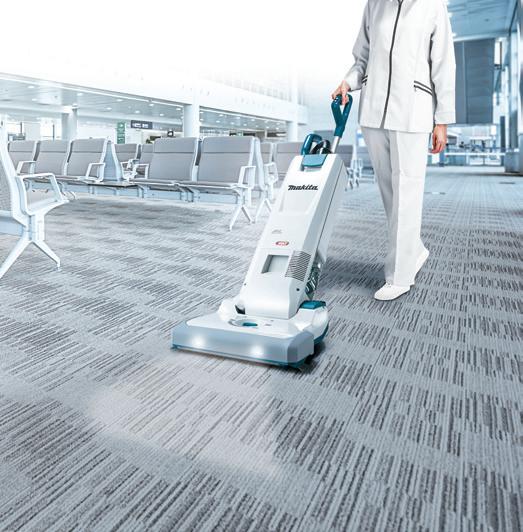

The VC010G also includes a 5-stage brushroll height adjustment for a variety of cleaning applications, and the brushes on each side of the cleaner head have been designed to easily remove the dust accumulated along and close to walls, without the user having to change the direction of the appliance. For additional manoeuvrability, the main body of the vacuum is able to tilt up to 90 degrees, allowing professionals to more easily reach tight places, such as under furniture.
MONTH IN FM TO ADVERTISE IN MONTH IN FM PLEASE CONTACT DANNY.GRANGE@KPMMEDIA.CO.UK OR CALL 01322 476811 MAY 2024 50
www.makitauk.com 020 8890 0586
https://go.ppltraining.co.uk/fmj-prod-news/hvf fmj@ppltraining.co.uk 0333 121 1215
NEW DEIB LEAD AT THE INSTITUTE OF HOSPITALITY
CEO APPOINTMENT AT ENVA


The Institute of Hospitality (IoH) has appointed Devarshi Shah AIH as its new Diversity Equity, Inclusivity and Belonging Lead (DEIB). The role, which fits within the Institute’s Professional Development team, is funded by the Savoy Educational Trust (SET) and is pivotal in informing, influencing, and supporting the Institute’s members, leading the global hospitality sector in DEIB, and championing key DEIB collaborations.
With over five years of experience in talent management and organisational development, Shah, who holds a master’s degree in human resources and organisations, was previously a Consultant and Lead of People and Culture at Great Place to Work® Institute, India where she worked closely with key stakeholders to drive culture, engagement, and inclusion initiatives.
The new role will focus heavily on creating educational resources, Continuing Professional Development (CPD), articles, publishing white papers, and case studies and supporting businesses and individuals with EDI strategies and best practices.
DIRECTOR OF PROJECTS APPOINTMENT AT ARCUS FM


Karl Lavery has been appointed as Director of Projects at Arcus FM. The appointment follows the recent acquisition of the Trios Group. Since the takeover in August 2023, Arcus FM has been working hard behind the scenes to explore how it can best serve its customers and people throughout the integration. This includes revitalising its projects division, Arcus Projects.
Lavery takes on the role as Director of Projects, transitioning from his role as Projects and Commercial Director at the Trios Group. With over 20 years of experience in leading operations, projects, and business development across construction, engineering, and commercial real estate, he brings a wealth of expertise to the role as the business continues on its growth trajectory.


Recycling and resource recovery business, Enva, has appointed James Priestley as its new Chief Executive O icer.
Priestley takes over the reins from Tom Walsh who, a er many successful years growing the Enva business, has decided to step down as part of the recent acquisition of Enva by I Squared Capital.
Priestley joins the business from Renewi, a leading waste-to-product business, where he was Managing Director of the company’s Specialities Division which includes businesses in the UK and Europe. A qualified chemical engineer, Priestley’s experience includes senior management roles at Ford, British Airways and Tesco.
Commenting on his new role, Priestley said: “I am excited to be joining Enva for the next stage in its journey. Enva and the wider resource recovery sector are vital to the continued development of the circular economy, a field in which I have been running businesses for the last seven years. I look forward to working with the Enva team and all our stakeholders to continue the growth and development of the business at this exciting time.”
Looking for FM candidates?

• Cost-e ective recruitment advertising
• Exposure to over 25,000 FM professionals
• Package deals


• Includes social media promotion • Advert can run until position filled –no fixed term
• Listings from as little as £250



FACILITIES MANAGEMENT JOURNAL JOBS
FACILITIES MANAGEMENT JOURNAL JOBS
jobs.fmj.co.uk MAY 2024 51 FMJ.CO.UK FM CAREERS - PEOPLE
OVERCOMING CHALLENGES
Ilaria Cantelli, Education Manager at Uptree on the importance of improving social mobility through education and more inclusive recruitment practices
In the UK today, your social background still highly impacts your opportunities in life.
Compared with other developed countries, the UK has a lower rate of social mobility, and people from lower socioeconomic backgrounds are far less likely to have the chance to climb the social ladder.
The Social Mobility Commission defines social mobility as “the link between a person’s occupation or income and the occupation or income of their parents”. Where there is a strong link, there is a lower level of social mobility. Where there is a weak link, there is a higher level of social mobility(i)
Recent events such as COVID-19 and inflation have only made the inequalities more striking. Ofcom estimated that in 2020, 1.14 million to 1.78 million pupils had no access to a laptop, or had to share with siblings or parents working from home, clearly impacting their learning opportunities. This is a distinct example of how social mobility is strongly
LATEST JOBS ON FMJ
FACILITIES AND ESTATE MANAGER
Salary: £40,272 - £48,450 per annum
Location: Salisbury, Bristol or Sheffield https://bit.ly/4aSF9Hi
FACILITIES SALES MANAGER
Salary: £40,000 - £60,000 pa plus Commission
Location: Ongar, Essex https://bit.ly/3y4Hu36
CHIEF ESTATES & CAPITAL PROJECTS OFFICER/COO
Salary: £65,010 - £71,729
Location: Sussex https://bit.ly/4df2x3d
outcomes and decreased social mobility.
WORK EXPERIENCE
Crucial for students from less advantaged backgrounds is the access to work experience opportunities o ered by employers to raise their awareness of industries and roles they may not otherwise have heard of. Reaching out to young people before they enter the workforce can have a big impact in tackling social mobility as it paves their way to more career options and equips them with the experience they need to apply for them.
At the same time, the benefits of attracting a diverse workforce for employers range from better decision making, more creative ideas, marketing expansion, improved employee performance and more. Moreover, engaging current employees in work experience events can be seen as a great growth opportunity and can lead to a more engaged workforce.



























































linked to equality of opportunity and why tackling social mobility is essential to guarantee a fairer society where talent and hard work determine how far people can go in life.
EDUCATION INEQUALITY
One of the first aspects to focus on to put an end to the inequality of opportunities is education. As expected, areas with better education outcomes develop more skilled individuals, and become more attractive to investment. For areas with lower education outcomes, the opposite is the case –trapping them in a low skills cycle.
In 2017, the Department for Education developed a Plan for improving social mobility through education, based on four ambitions(ii). These focus on improving the education system to ensure that people from all backgrounds have the right knowledge about career paths and ensuring that this e ort in growing potential doesn’t stop when they leave school.
Young people from lower socioeconomic backgrounds are less likely to have access to careers advice and guidance; this might be due to a lack of in-school careers provision, or it might be because they do not have the same connections through family or peers that can o er knowledge and advice on of how to access the careers, as those from more advantaged backgrounds. This leads to lower career
Companies like Uptree(iii) support employers in engaging with diverse young people from across the UK. We work directly with schools, which means we can target specific groups of young talent more e ectively. We can help employers meet students face-to-face, build a talent pipeline for the future, and become an employer of choice amongst young people.
Attracting a more diverse pool is only the first step. It is essential for organisations to make sure that their recruitment process is as inclusive as possible. Some actions that can be put into place include:
Making sure the application process is clear and it outlines what the company is looking for.
Diversifying the interviewing panel. This helps remove unconscious bias and helps candidates identify with your employees.
Where possible removing academic requirements and being open to those without degrees.
Recognising the cost-of-living crisis- o er paid internships or consider financial support measures such as travel reimbursement.
Making the most of remote working by opening positions to those from less developed areas. Data is another powerful tool. Collecting information from your current employees about their socioeconomic background and how they are progressing within the company can help you better understand your organisation. This data can reflect how e icient your policies are and where you can implement them. You can also compare your findings with other companies on the Social Mobility Employer Index(iv)
REFERENCE NOTES
(i) https://bit.ly/3wctvI2
(ii) https://bit.ly/3JAyKEC
(iii) https://uptree.co/employers/
(iv) www.socialmobility.org.uk/employerindex
FACILITIES MANAGEMENT JOURNAL JOBS
jobs.fmj.co.uk Over 250 jobs live on site FM CAREERS
RECRUITMENT
-
MAY 2024 52
FM CAREERS - TRAINING
DEALING WITH CONFLICT
FMJ reports on a new training programme that helps prepare front-line personnel manage conflict by providing simple strategies and universal guidance to manage interventions professionally and e ectively

Earlierthis month the government announced a series of measures to combat the rising tide of abuse and attacks on retail sta . Among the measures announced, the Home O ice has pledged £55.5 million investment in facial recognition technologies and plans are now afoot to make assaults on shopworkers a standalone criminal o ence.
Front-line facilities management people may sympathise with the plight of retailers. Unfortunately, many are no strangers to the sorts of incidences of conflict and violence that have exploded on Britain’s high streets of late. From hospitals and shopping centres to restaurants and o ice buildings, nowhere seems to be immune to the challenge of coming into conflict these days.
EQUIPPING STAFF
One organisation that is helping the facilities management industry to fight back is People 1st international. The customer service training experts, who are perhaps best known for the WorldHost Principles of Customer Service training, has decided to act and help equip customer facing sta with the skills and competencies to de-
escalate potential conflict situations.
Last month they launched the WorldHost Dealing with Conflict training following an extensive pilot across the UK and Ireland.
Explaining why People 1st International deemed it necessary to introduce this training for firms their Executive Director, Jane Rexworthy said: “It is regrettable that the growing trend of increased customer hostility towards customer-facing sta has meant that the ability to e ectively resolve conflicts has become an all but essential skill.
“Reflective of the fact, in our most recent survey of 250 retail and hospitality businesses, the ability to resolve conflict was identified as one of the top in-demand skills by employers, meaning that training to help employees deal with potential conflict is paramount.”
POSTITIVE OUTCOMES
The training programme is designed to enable customer-facing sta to turn negative and potentially dangerous interactions into positive ones, and has been delivered to a range of companies from security firms to community sports organisations so far.
Manguard Plus was one of the companies that piloted the programme earlier this year, with a session delivered to the security team at the o ices of Workday – a global so ware company - located in Dublin.
“Having reviewed the content in advance of the training I was very impressed with the holistic approach WorldHost has taken to addressing the complex topic of conflict management,” said Finbarr McCarthy, Director EMEA Safety & Security GWS at Workday.
“The team thoroughly enjoyed the training session, specifically the opportunity to engage and share experiences, with feedback from the group being very positive.
“The WorldHost products provided to Workday’s security team by Manguard Plus has greatly enhanced the skills and awareness of the team which is evident in the positive feedback received from internal customers since training has commenced. I look forward to expanding these training programmes across the wider front-ofhouse teams at Workday.”
DEESCALATING CONFLICT
The one-day face-to-face programme
helped to equipped sta with knowledge and awareness to recognise the signs of anger as well as receiving a grounding in appropriate language and actions for conflict situations to help minimise incidents of attacks and abuse.
“Through the training, I learnt about the di erent tools to support dealing with and deescalating angry and abusive customers,” said one of the training participants that took part in the pilot.
“It reinforced the importance of situation awareness and made me think about my own reactions and responses. Every element of the programme was relevant to my job role and the situations I can encounter. I’d recommend the programme to others,” they continued.
As an organisation that works across national borders and across socioeconomic and cultural boundaries, the People 1st International WorldHost Dealing with Conflict Training Programme is designed and intended for universal delivery in a variety of roles in a variety of contexts.
Garry Bergin is an experienced trainer, who specialises in mentoring and upskilling in-house security teams.
“Since implementing this programme, we have observed a notable improvement in client interactions and a positive shi in our organisation's service quality. I highly recommend the WorldHost programme for any entity seeking to elevate their customer service standards and manage conflicts with professionalism and ease.”
The new training programme is just one example of how the industry is taking the initiative and fighting back against the abuse front-of-house, security and other customer-facing sta . Industry bodies and insiders will therefore be hopeful that interventions such as these will help to prevent the abuse of sta reaching the scale of that witnessed on the high street.
MAY 2024 53 FACILITIES MANAGEMENT JOURNAL JOBS
Pareto FM welcomes new apprentices at Whipsnade and London Zoo
Pareto FM has announced the appointment of three new apprentices, with one joining the team at Whipsnade and two at London Zoo. These valuable additions highlight Pareto's dedication to nurturing talent and providing outstanding service in diverse environments.
The apprentices will embark on a comprehensive training program under the guidance of experienced professionals, gaining hands-on experience in various facets of facilities management. Through this apprenticeship, they will have the opportunity to develop essential skills and knowledge while contributing to the operational excellence of both Whipsnade and London Zoo.
"We are delighted to welcome our new apprentices to Pareto FM," said Dave Richards, CEO at Pareto FM. "Their passion for learning and dedication to excellence align perfectly with our values, and we look forward to supporting them on their journey towards becoming skilled professionals in the facilities management industry."
Fit notes need to be more e ective says SOM
The Society of Occupational Medicine (SOM) is calling for a review of fit notes by health professionals trained in occupational health to support their better use. Statistics show that currently over a third of fit notes are issued for five weeks or longer, by which time around 20 per cent of people will never return to work.
Retaining skilled talent remains a top challenge for employers
Some of the biggest challenges for UK organisations include skilled talent retention, meeting pay expectations, providing a good work-life balance, and supporting employees’ wellbeing, suggests research by HR so ware provider Ciphr.
Over half (51 per cent) of respondents reported employee retention as their top worry for the year ahead. Many (46 per cent) also think that their organisation could struggle to meet employees’ expectations around wages, worklife balance, and mental health and wellbeing support.
Over four in 10 (45 per cent) organisations also expect to find recruitment, employee engagement, and managing remote and hybrid working expectations challenging.
Other key concerns include providing a good employee experience (42 per cent), closing skills gaps (42 per cent), reducing absenteeism (41 per cent), and ensuring a positive workplace culture (41 per cent).
Commenting on the survey findings, Claire

Williams, Chief People and Operations O icer at Ciphr, said: “Many organisations are also being impacted by tighter budgets as they are having to invest in new technologies, increase their compliance standards and levels of professionalisation, and mature their business to keep up with competitors and the market.
“Investing in your people, however, doesn’t necessarily need huge budgets. It does require leaders to invest in a di erent mindset though. Those that fail to recognise and respond to these challenges will ultimately be le behind.”



People seeing their GP team expect an all or nothing ‘sick note’. This makes it harder to manage expectations and come to a shared decision about using the ‘may be fit for work’ option. Discussing the merits of the ‘may be fit for work’ section, or a shorter review period before reassessment can be perceived as punitive by patients who expect to get ‘signed o ’ and find it di icult to understand why their GP team would challenge this. That is why SOM is calling for tailored occupational health advice to be made available to patients who receive the fit note - with better use of the 'maybe fit' for work section.
SOM is also calling for comprehensive training in fit note use, including essentials in occupational health, in clinical and medical training curricula.
SOM would like to see fit note certification acting as a triaged referral point to an occupational health professional to support return to work, and skills in occupational health (OH), are barriers to using the fit note to its full potential in general practice.
Only 50 per cent of UK employees have access to OH and the Government needs to fund OH to support people with health issues to return to, and stay at, their workplace argues the SOM.
BESA unveils NextGen network, with tackling the skills gap a priority
A dedicated group for young engineers and newcomers to the industry has been launched by the Building Engineering Services Association (BESA). The BESA NextGen network replaces the Association’s ‘Future Leaders’ group which was formed in 2017 to support young engineers working for member companies who were seen to have future management potential.

The new network is more broadly based and aims to provide technical knowledge, career support, and networking opportunities for younger engineers and those in the early stages of a building engineering career working for both member and non-member companies. It is also open to young people employed in non-engineering roles in the building services sector.
Ryan Walton, Specification Engineer at Panasonic Heating and Cooling, is the first Chair of the network having already served as Chair of the Future Leaders group since April last year.
He said: “It is a real honour and a great opportunity to work with my fellow young engineers through this exciting initiative. We have a lot to o er the Association and the wider industry, but it is o en hard for us to make our collective voice heard.”
Tackling the skills gap is a priority for the network and it identified mentoring as an important way for experienced colleagues to provide support. Its members have also suggested ‘shadowing’ a senior colleague or someone in a di erent role as a good way to gain broader industry experience.
They also believe there is an important place for ‘reverse mentoring’ where younger members of sta provide advice and guidance to management. This can be particularly useful around emerging technologies and new ideas for projects.
FM CAREERS - NEWS FACILITIES MANAGEMENT JOURNAL JOBS
MAY 2024 54

Take complaints off your to-do list

The Tork Office Hygiene Package
67% of employees say that they are more likely to complain about a washroom than any other aspect of their office.* Cut complaints by ensuring that cleaning and washroom maintenance are run well and efficiently with the Tork Office Hygiene Package.™
tork.co.uk/officehygiene
*June
America
Tork,
2022 Behaviourally – Qualitative and quantitative office segment research with 600+ respondents in North
and Europe.
an Essity brand.



























































































































































































































































































































































































































































































































